Transforming your backyard into an engaging playground for kids doesn't require expensive equipment or massive renovations. Today's best backyard designs focus on creating multiple themed zones that spark imagination, encourage physical activity, and connect children with nature. From adventure-packed obstacle courses to peaceful sensory gardens, these 25 backyard ideas blend safety with excitement. Each concept represents a complete design theme that addresses layout, materials, activities, and long-term enjoyment. Whether you have a compact urban space or sprawling suburban yard, these kid-friendly designs will create lasting memories while promoting healthy outdoor play.

1. Adventure Tree Fort with Multi-Level Platforms
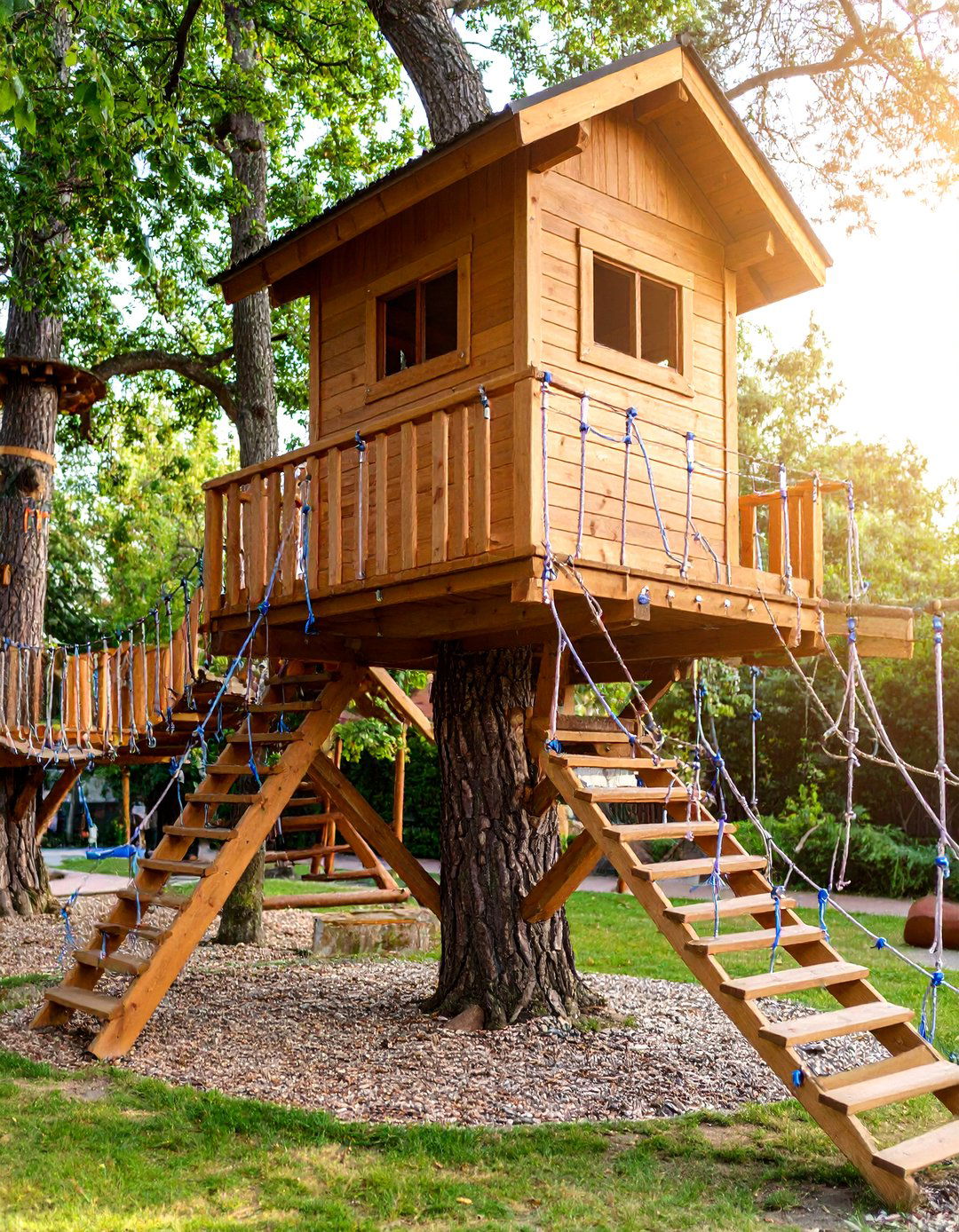
An elevated tree fort creates the ultimate backyard adventure zone, featuring multiple connected platforms at varying heights with rope bridges, climbing walls, and secret compartments. This wooden structure incorporates natural materials like cedar planks and sturdy rope elements, designed around existing trees or supported by custom posts. The multi-level design includes a main clubhouse area with windows and a door, plus smaller observation decks connected by safe walkways. Underneath, the shaded space serves as a natural gathering area with built-in seating and storage for outdoor toys. Safety railings and non-slip surfaces ensure secure play while maintaining the rustic, adventurous aesthetic that makes kids feel like real explorers in their own backyard kingdom.
2. Natural Sensory Garden with Interactive Plant Elements
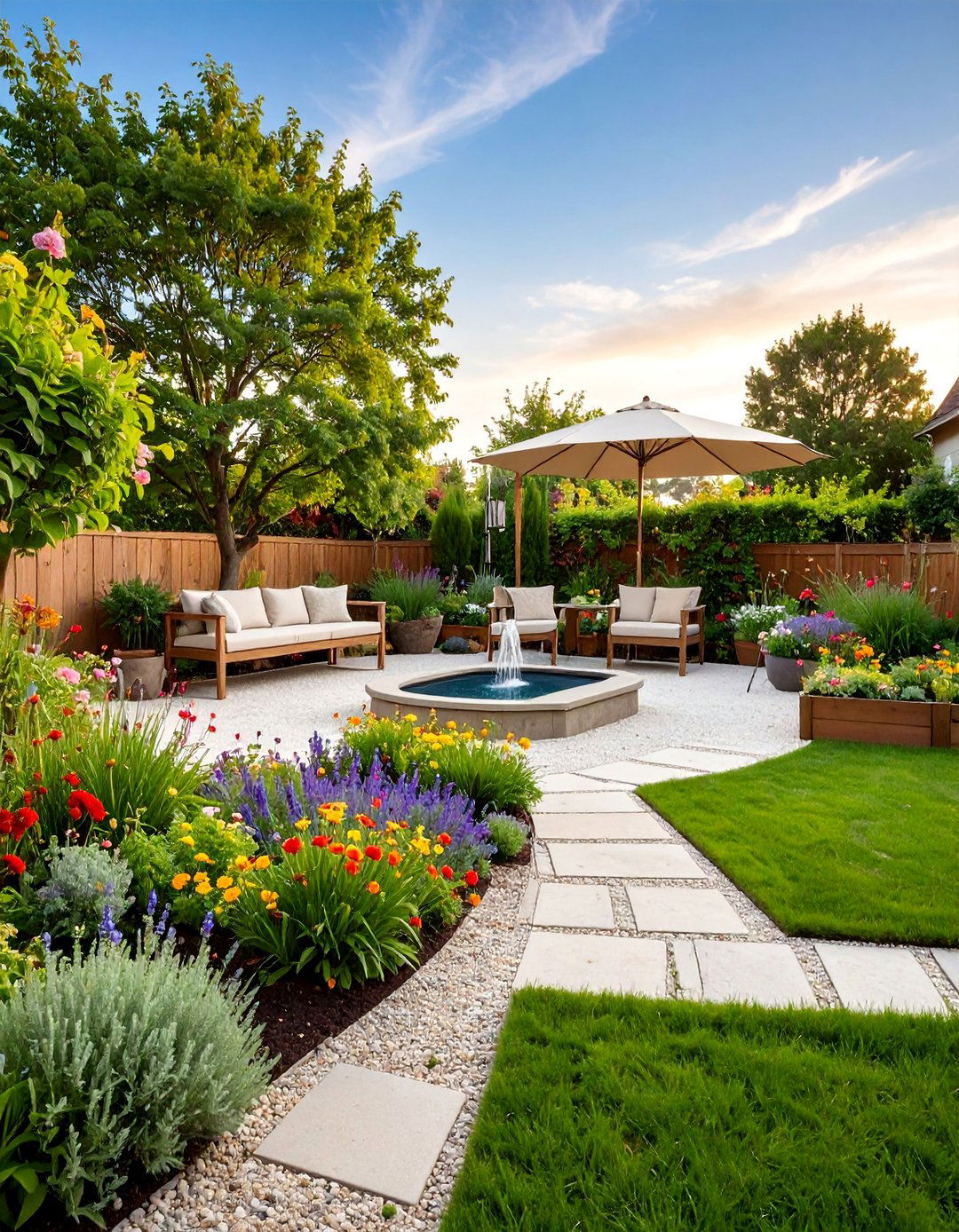
A dedicated sensory garden transforms part of your backyard into an immersive learning environment where kids explore through touch, smell, sight, and taste. This themed area features raised beds filled with textured plants like lamb's ear, aromatic herbs including mint and lavender, colorful flowers, and edible options such as cherry tomatoes and strawberries. Winding gravel pathways connect different sensory stations, while strategically placed wind chimes and water features add auditory elements. The design incorporates child-height planting areas, built-in seating made from natural stone, and hidden discovery spots where kids can find interesting textures and fragrances. This garden environment encourages curiosity while teaching children about nature's diversity and the importance of caring for living things.
3. Splash Zone Water Park with Multiple Play Features
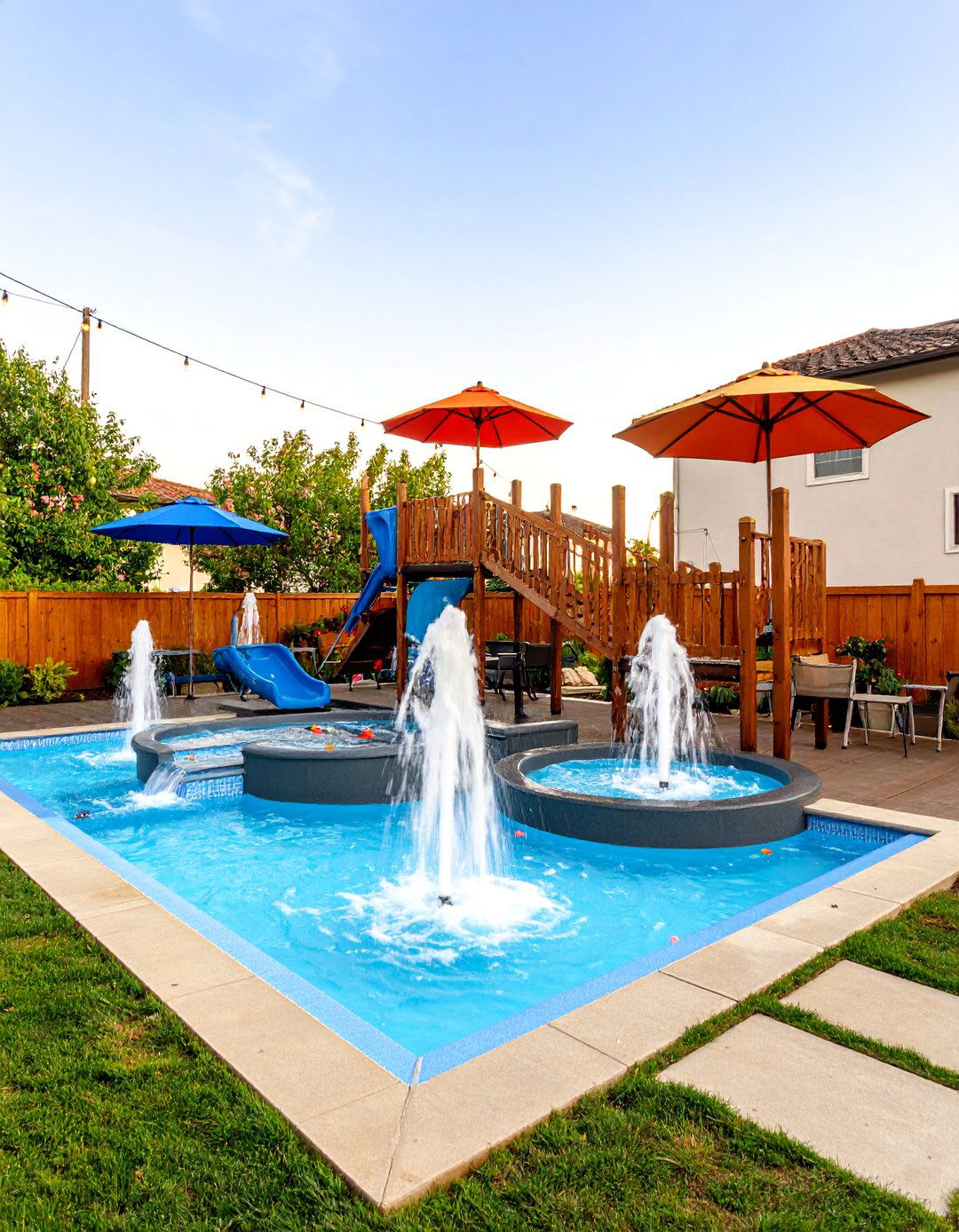
Create an exciting water playground by combining various splash elements into one cohesive backyard water park design. This area features a central splash pad with ground jets, surrounded by water tables at different heights, a small wading pool, and interactive water walls made from recycled materials. The zone includes shade structures like colorful umbrellas or sail cloths, plus nearby seating for supervision. Non-slip surfaces throughout ensure safety, while a dedicated drainage system prevents muddy conditions. Storage solutions keep water toys organized and easily accessible. The design can be scaled for any yard size and includes options for both permanent installations and temporary summer setups, making it perfect for beating the heat while promoting active water play.
4. Obstacle Adventure Course with Natural Challenges

Design a comprehensive obstacle course using natural materials and simple equipment to create an adventure playground that builds strength, coordination, and problem-solving skills. This backyard feature incorporates tree stumps for stepping, fallen logs for balance beams, tire obstacles for crawling, rope elements for climbing, and pool noodle hurdles for agility training. The course layout creates a flowing path through the yard with various difficulty levels accommodating different age groups. Safety considerations include proper spacing between obstacles, soft landing areas with mulch or grass, and clear sight lines for supervision. The natural aesthetic blends seamlessly with existing landscaping while providing endless opportunities for creative play and physical challenges that keep kids engaged and active throughout the seasons.
5. Outdoor Mud Kitchen with Real Cooking Features
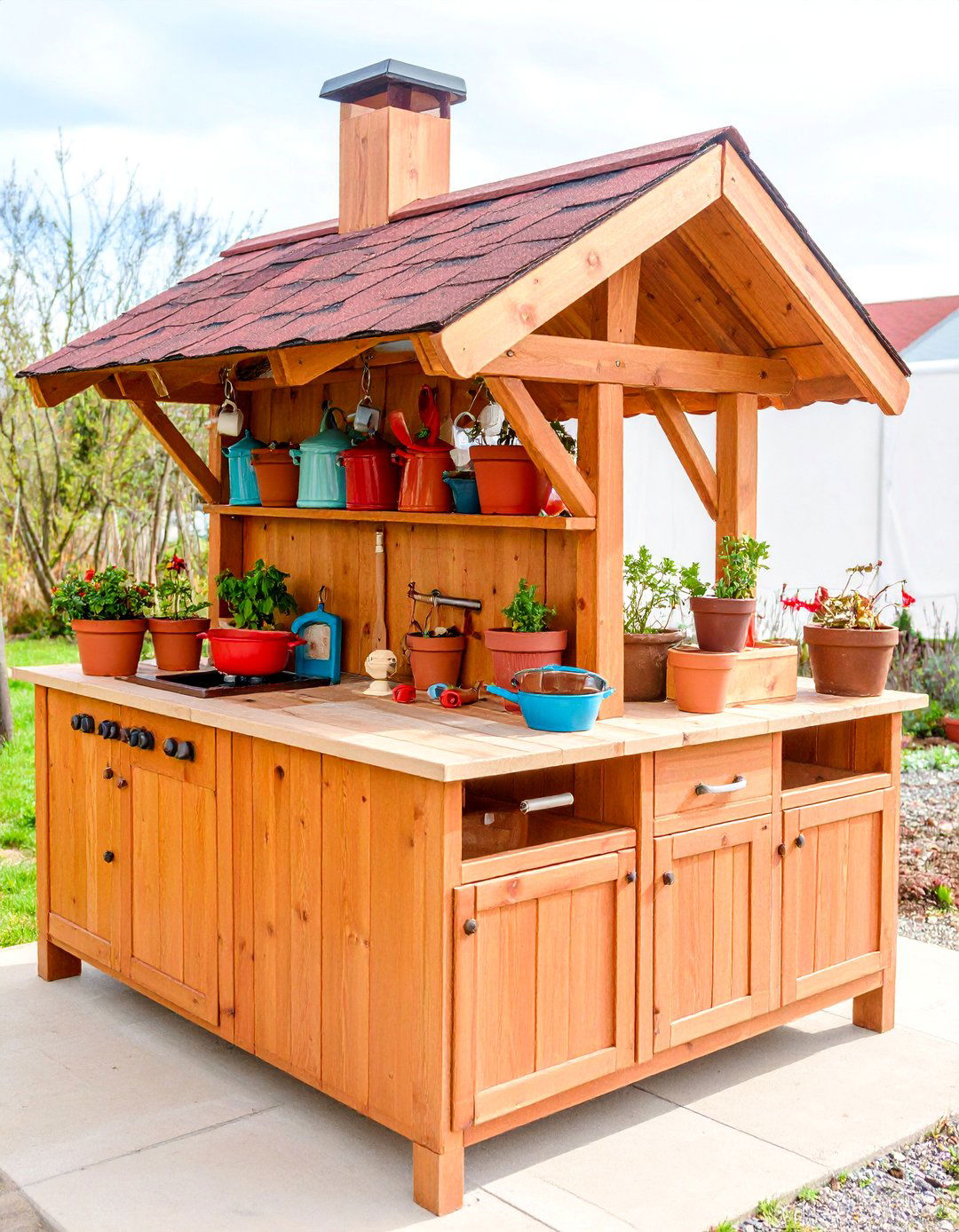
An outdoor mud kitchen provides kids with their own culinary adventure space, featuring child-sized counters, sinks with working pumps, storage for pots and utensils, and prep areas for creating natural concoctions. This wooden structure includes multiple work stations, hooks for hanging tools, and shelving for ingredients like leaves, flowers, and safe natural materials. The design incorporates a roof for weather protection and is positioned near a water source for easy cleanup. Built-in planters allow kids to grow herbs for their mud recipes, while nearby seating creates a dining area for sharing their creations. This installation encourages imaginative play, teaches basic cooking concepts, and provides a contained area for messy outdoor fun that parents can easily supervise and maintain.
6. Castle Playhouse with Medieval Adventure Theme
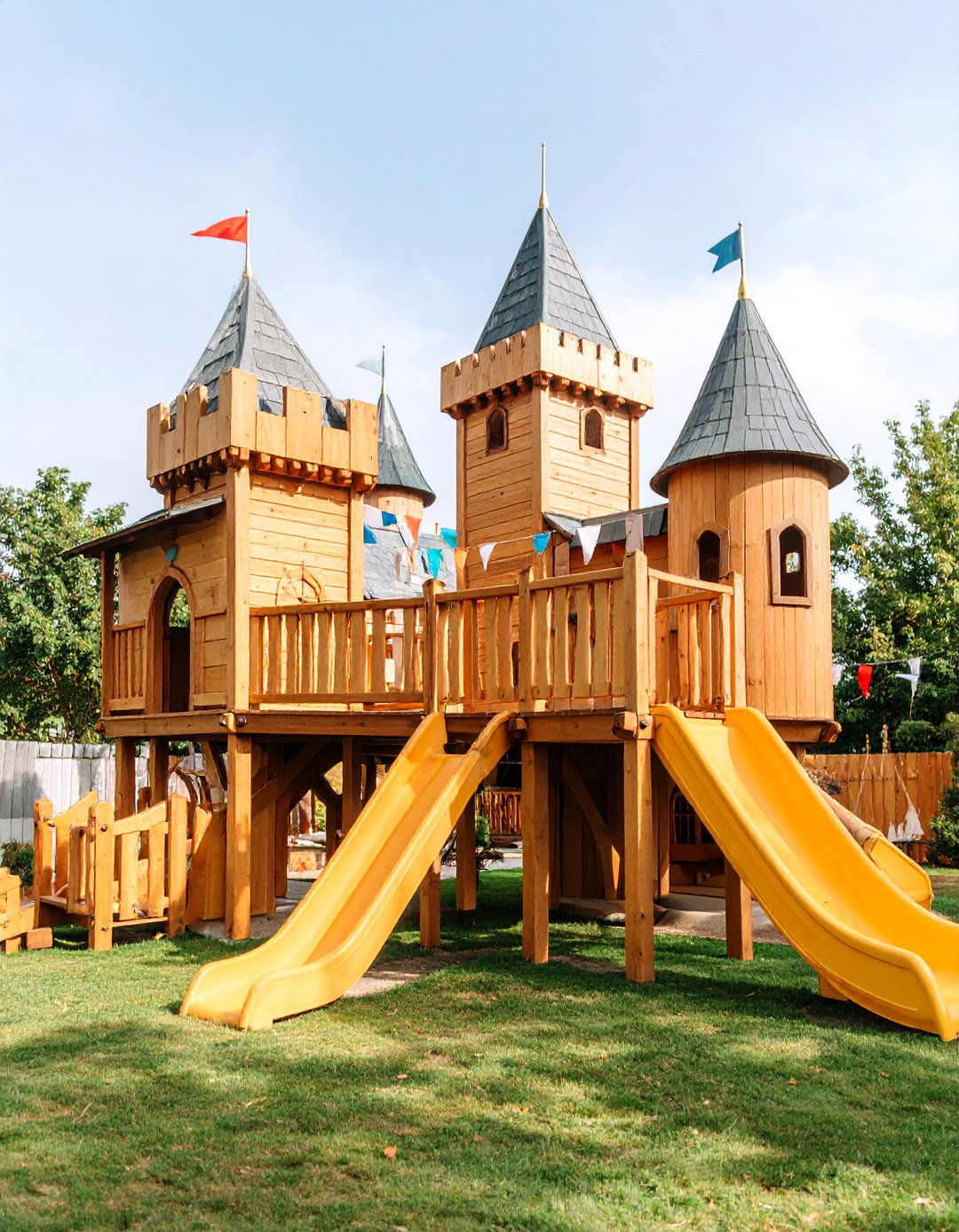
Transform your backyard into a medieval kingdom with a castle-themed playhouse featuring turrets, battlements, a drawbridge, and secret passages. This elaborate wooden structure includes multiple levels, climbing walls designed as castle towers, and a slide that serves as an escape route. The design incorporates medieval details like flags, a coat of arms, and period-appropriate colors, while maintaining modern safety standards with proper railings and secure construction. The ground level features a fortress entrance with heavy doors and may include a dungeon area for imaginative play. Surrounding landscaping can enhance the theme with a moat garden, medieval herb plots, and pathways that complete the royal atmosphere while providing educational opportunities about history and architecture.
7. Nature Trail Discovery Path with Learning Stations
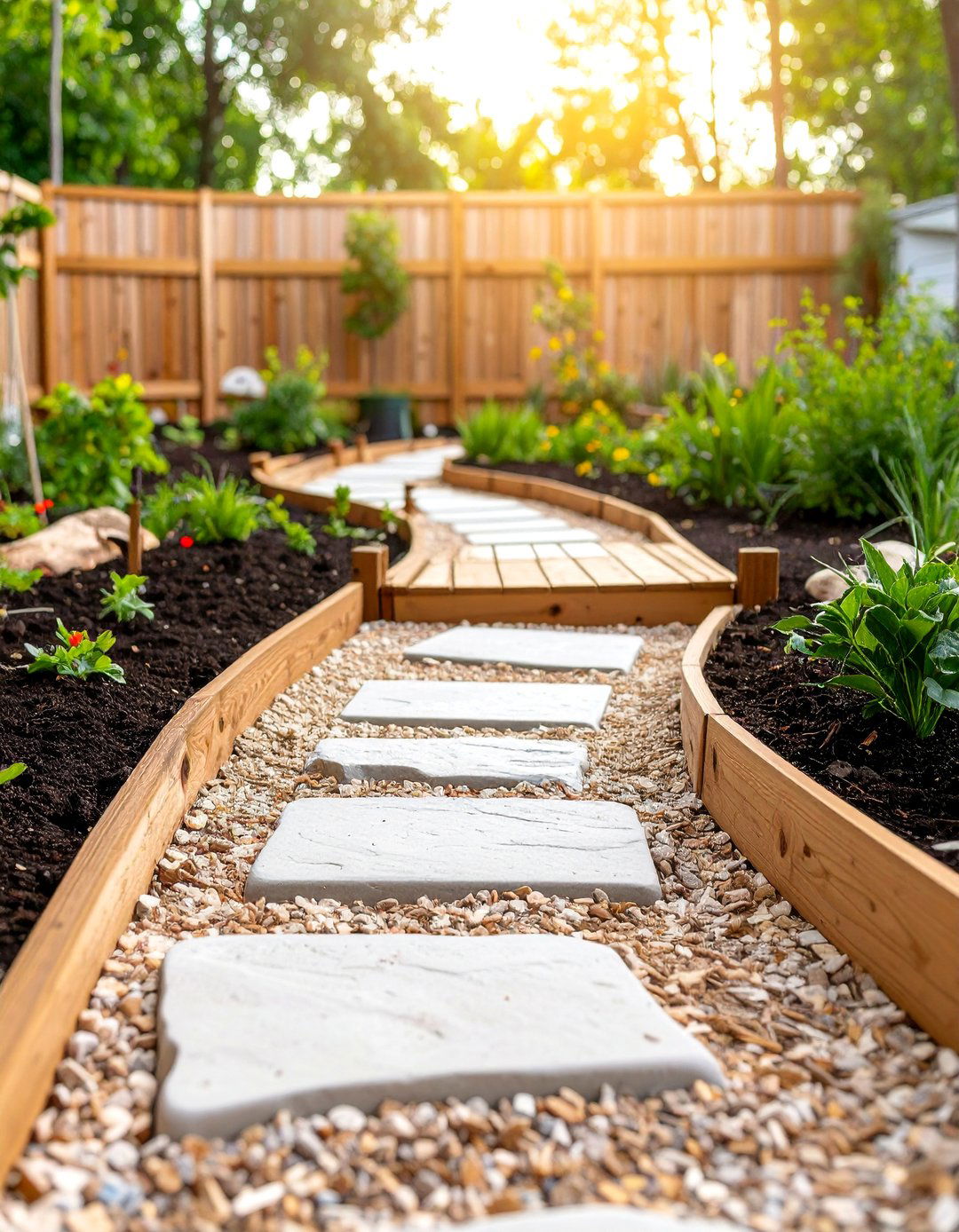
Create an educational adventure by designing a winding nature trail that guides kids through different discovery stations positioned throughout your backyard. This path system features stepping stones, wooden bridges over planted areas, and designated stops with interactive elements like bug hotels, bird watching stations, and plant identification markers. The trail incorporates natural materials such as wood chips for pathways, log borders, and strategically placed boulders for seating and climbing. Each station offers hands-on learning opportunities about local wildlife, plant life, and environmental concepts. The design encourages exploration and scientific thinking while providing gentle exercise through walking and climbing. This concept works well in larger yards and can be adapted to highlight existing natural features like mature trees, rock formations, or garden areas.
8. Sandbox Construction Zone with Builder Theme

Design a comprehensive sandbox environment that goes beyond simple sand play by creating a construction-themed zone complete with diggers, dump trucks, and building materials. This area features a large, bordered sandbox with multiple levels and sections for different types of play, including areas for road building, castle construction, and archaeological digs. The design includes built-in storage for tools, toy vehicles, and molds, plus a wash station for easy cleanup. Overhead shade protection keeps the area comfortable during sunny days, while proper drainage prevents water accumulation. The construction theme extends beyond the sandbox with nearby areas for block building using large outdoor blocks, creating a complete builder's paradise that encourages engineering thinking and cooperative play among children.
9. Climbing Rock Wall Adventure with Natural Elements

Install a climbing rock wall that combines artificial holds with natural rock features to create an exciting vertical challenge in your backyard. This structure can be built against an existing fence, retaining wall, or as a freestanding feature, incorporating various difficulty levels suitable for different ages and skill levels. The design includes safety features like proper fall zones with soft mulch or rubber matting, secure anchor points, and age-appropriate hand and foot holds. Natural elements like integrated planters with climbing vines add visual appeal while creating a more organic appearance. The climbing area can include additional challenges like rope elements, cargo nets, or traverse walls that extend the adventure horizontally. This installation promotes physical fitness, builds confidence, and provides a unique focal point that encourages active outdoor play.
10. Sports Court Multi-Game Arena with Flexible Design

Create a versatile sports area that accommodates multiple games and activities through smart design and flexible court markings. This backyard feature includes a hard surface suitable for basketball, tennis, volleyball, and various ball games, with removable or adjustable nets and goals. The court design incorporates proper drainage, non-slip surfaces, and adequate safety zones around the perimeter. Colorful court markings can designate different game areas, while modular equipment allows for easy reconfiguration based on the activity. Seating areas and storage solutions keep sports equipment organized and accessible. The surrounding landscape can include impact-resistant plants and proper fencing to contain balls while maintaining an attractive appearance. This design encourages physical fitness, social interaction, and skill development across multiple sports.
11. Fairy Garden Magic Village with Miniature Landscapes
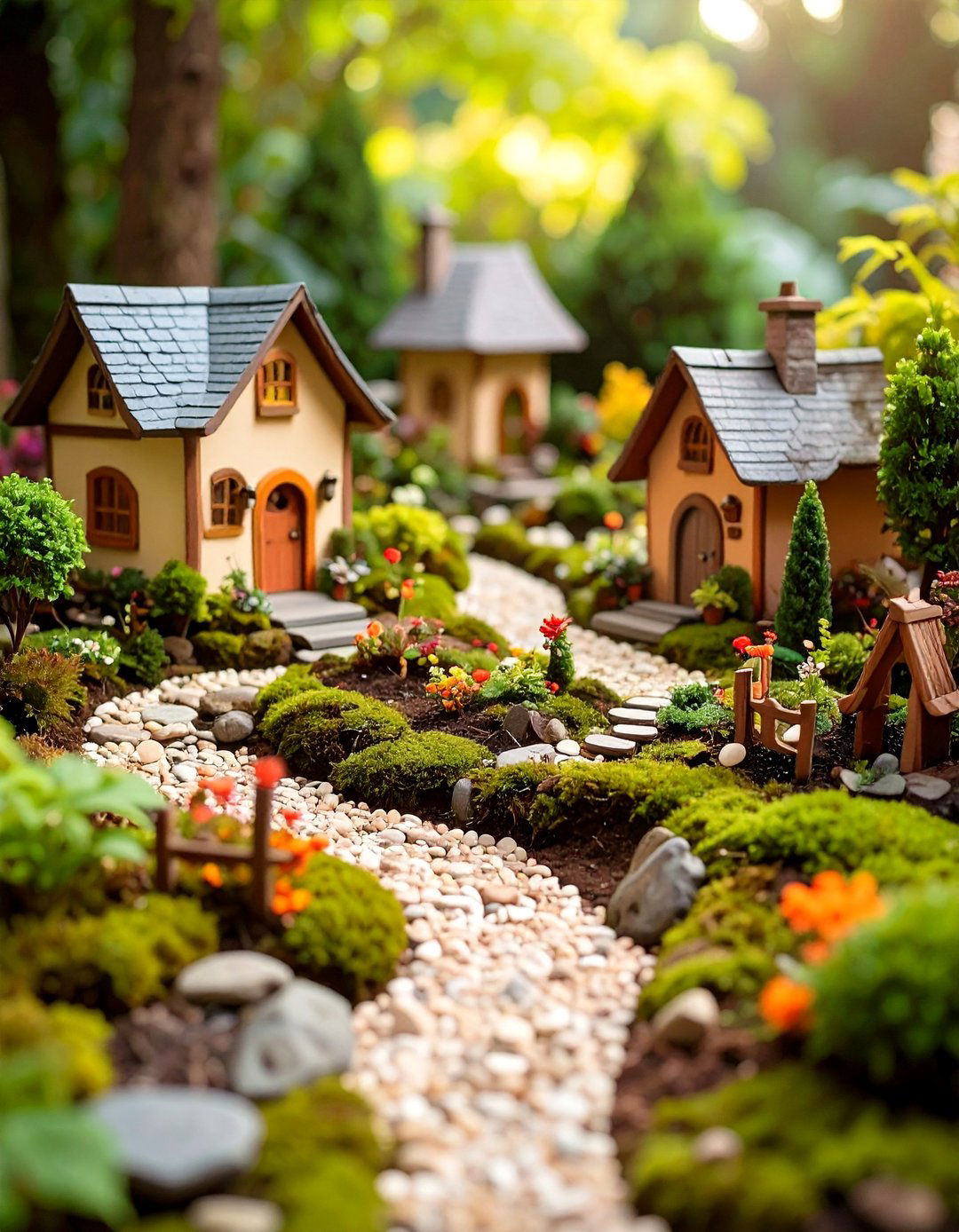
Design an enchanting fairy garden area that sparks imagination through miniature landscapes, tiny houses, and magical themed elements scattered throughout a dedicated section of your backyard. This whimsical space features small-scale gardens with child-friendly plants, miniature pathways made from pebbles or small stones, and tiny furniture crafted from natural materials. The design incorporates hiding spots for fairy houses, secret doors attached to trees, and small water features like tiny ponds or streams. Interactive elements allow kids to rearrange decorations, plant seeds in mini gardens, and create their own fairy stories. The area includes seating at child height for comfortable play and nearby storage for fairy accessories. This magical environment encourages creative storytelling, nurtures a love of gardening, and provides a peaceful space for imaginative play.
12. Swing Paradise with Multiple Movement Options

Create a comprehensive swinging area that goes beyond traditional swing sets by incorporating various types of swings and movement equipment into one exciting zone. This area features classic belt swings, tire swings, rope swings, and specialty options like disc swings or glider swings, all properly spaced for safety. The design includes different height options to accommodate various age groups, with some swings attached to trees and others to custom-built structures. Safety considerations include proper fall zones with appropriate ground covering, secure mounting hardware, and regular inspection points. The swing area can incorporate nearby seating for supervision and storage solutions for swing accessories. This movement-focused design promotes vestibular development, provides emotional regulation opportunities, and creates a social gathering space where kids can play together or enjoy quiet swinging time.
13. Reading Nook Garden Library with Comfortable Seating
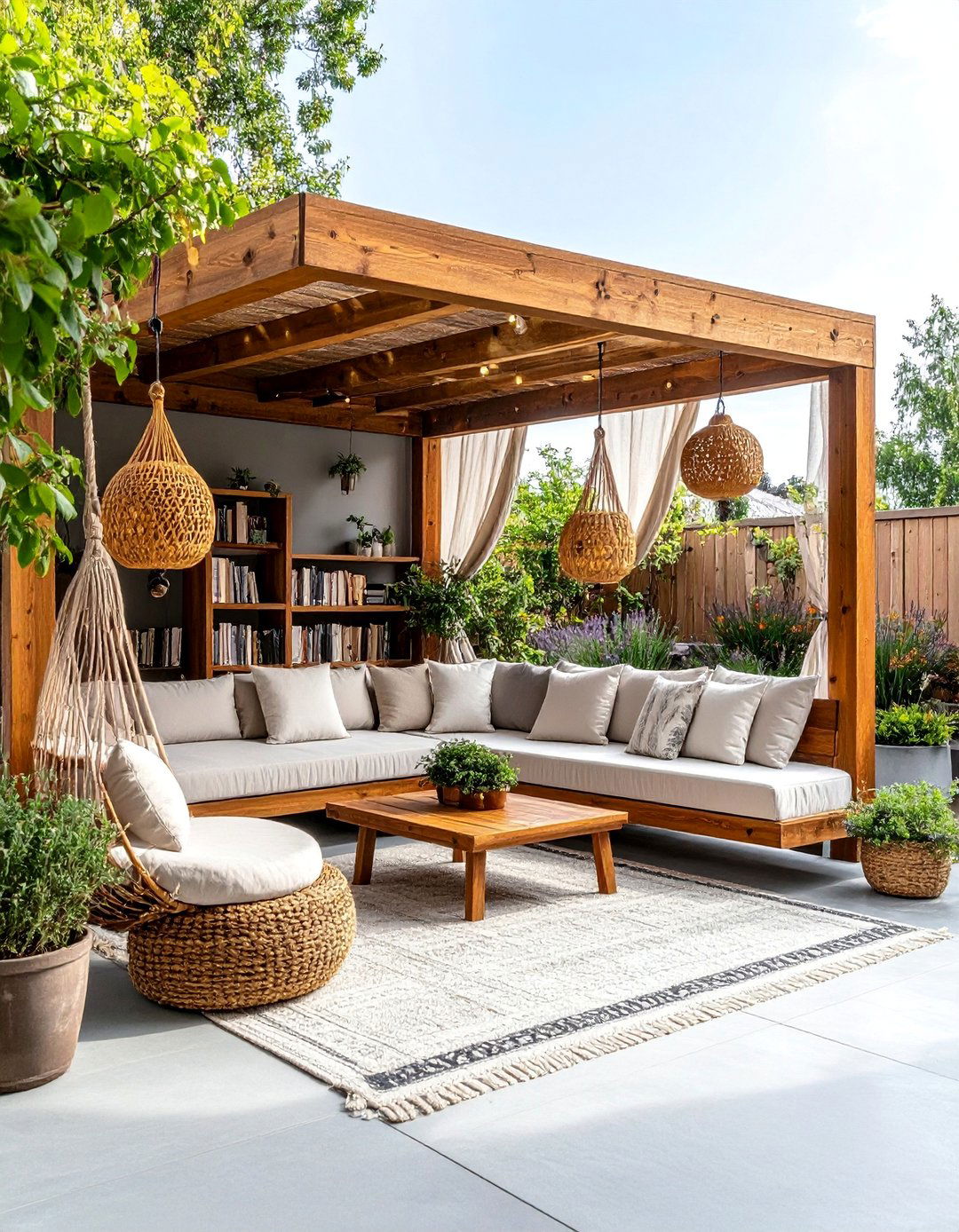
Design a peaceful outdoor reading space that combines comfortable seating with natural elements to create an inviting library environment in your backyard. This quiet zone features weather-resistant seating options like built-in benches with storage underneath, hanging pod chairs, or cozy outdoor cushions arranged around a central focus point. The area includes natural shade from trees or installed shade structures, plus protection from wind and visual distractions. Built-in shelving or weatherproof storage containers keep outdoor books and reading materials accessible and protected. The design incorporates sensory elements like aromatic plants, wind chimes, and textured pathways that enhance the peaceful atmosphere. This reading retreat encourages literacy development, provides a calm space for decompression, and creates positive associations between nature and learning.
14. Art Studio Outdoor Creative Space with Messy Play Areas

Transform part of your backyard into an outdoor art studio where kids can engage in creative projects without worrying about indoor mess. This area features easels, work tables at appropriate heights, and storage solutions for art supplies, all designed to withstand weather exposure. The space includes dedicated areas for different types of art, such as painting walls made from chalkboard paint, sculpture areas with clay and natural materials, and craft stations with organized supply storage. Proper drainage handles water from art activities, while nearby water access facilitates cleanup. The design incorporates moveable shade structures that allow for comfortable work during various weather conditions. This creative environment encourages artistic expression, develops fine motor skills, and provides opportunities for both independent and collaborative art projects.
15. Trampoline Activity Zone with Safety Integration
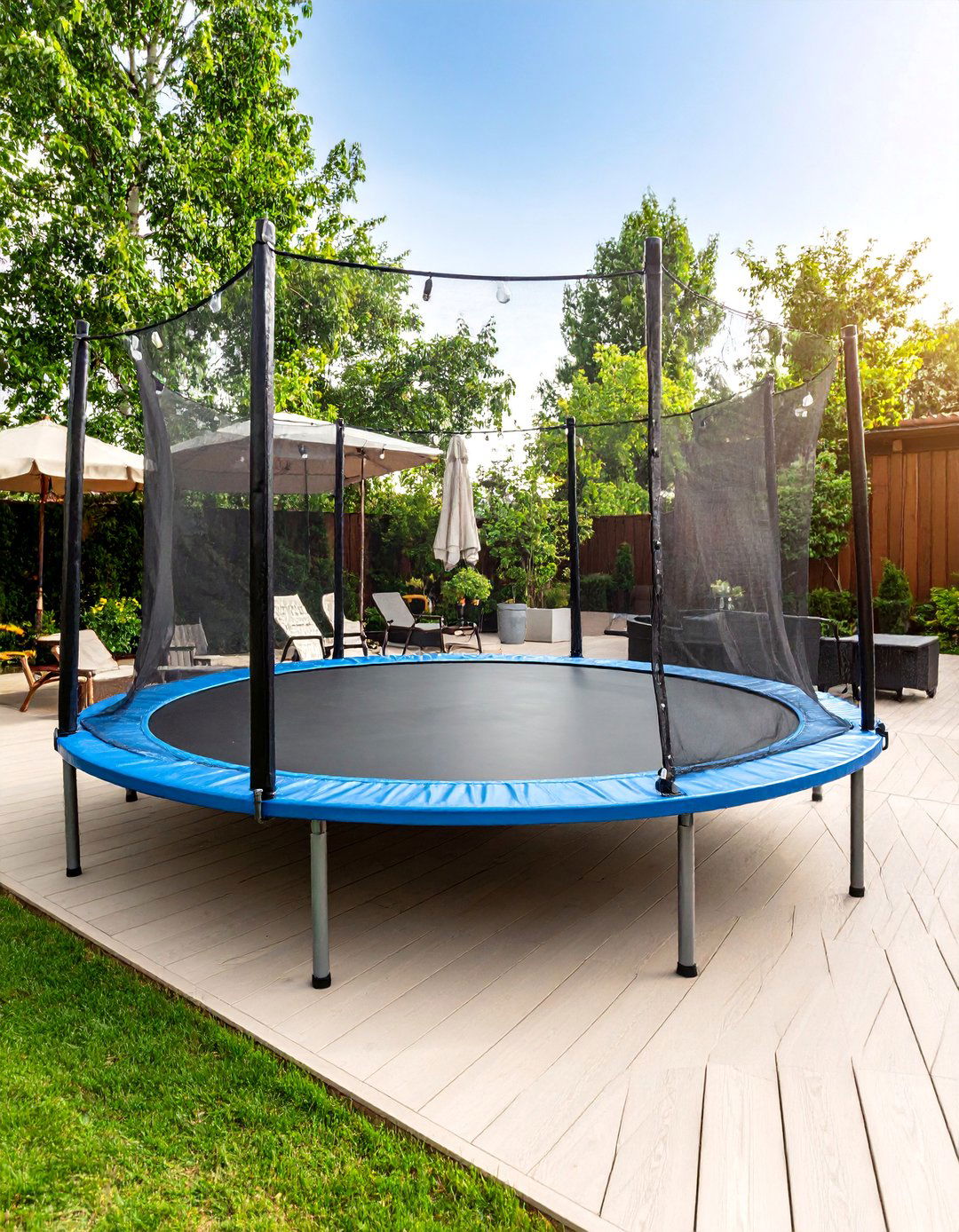
Design a safe and exciting trampoline area that maximizes fun while prioritizing safety through thoughtful placement and surrounding features. This zone features a quality trampoline with proper safety netting, positioned with adequate clearance from structures, trees, and property lines. The surrounding area includes soft landing zones with appropriate ground covering, seating for supervision, and storage for trampoline accessories. The design incorporates lighting for evening use, drainage to prevent water accumulation, and easy access paths. Additional activity options near the trampoline might include ground-level balance beams, hop scotch patterns, or other movement activities that complement bouncing play. This high-energy zone promotes cardiovascular fitness, balance development, and provides an outlet for energetic play that kids can enjoy year-round with proper maintenance and supervision.
16. Garden Learning Laboratory with Hands-On Growing Spaces
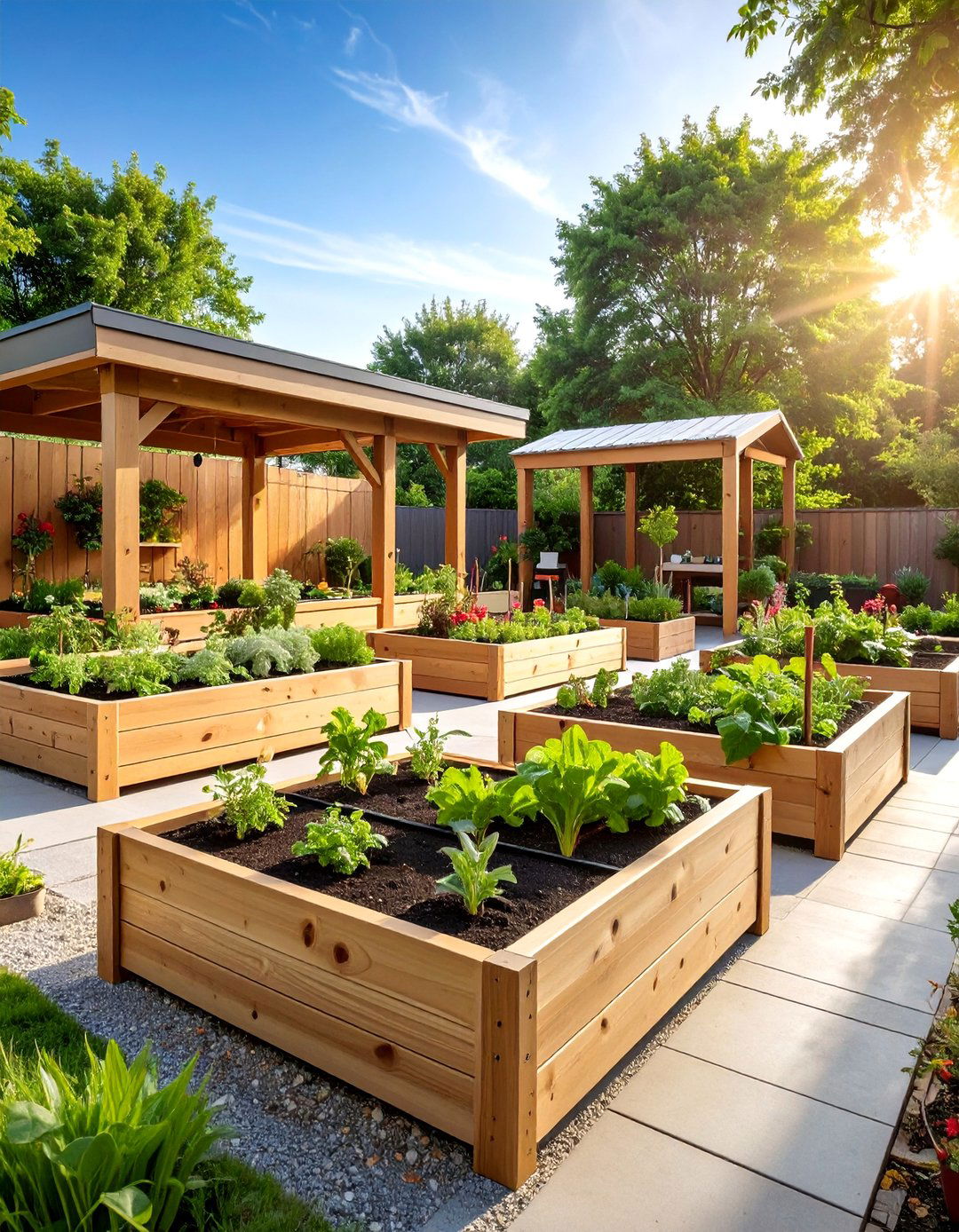
Create an educational garden space where kids learn about plant life cycles, nutrition, and environmental responsibility through hands-on growing experiences. This area features raised beds at child-appropriate heights, clearly marked planting areas, and storage for gardening tools and supplies. The design includes demonstration areas for composting, seed starting stations, and harvest preparation spaces. Educational elements like plant identification markers, growth measurement stations, and weather monitoring tools enhance the learning experience. The garden incorporates fast-growing plants for quick results, sensory plants for exploration, and edible options that connect gardening to nutrition education. Pathways allow easy access to all areas while protecting growing plants. This living classroom teaches responsibility, patience, and scientific observation while providing fresh ingredients for outdoor cooking activities.
17. Music Garden Sound Exploration with Natural Instruments
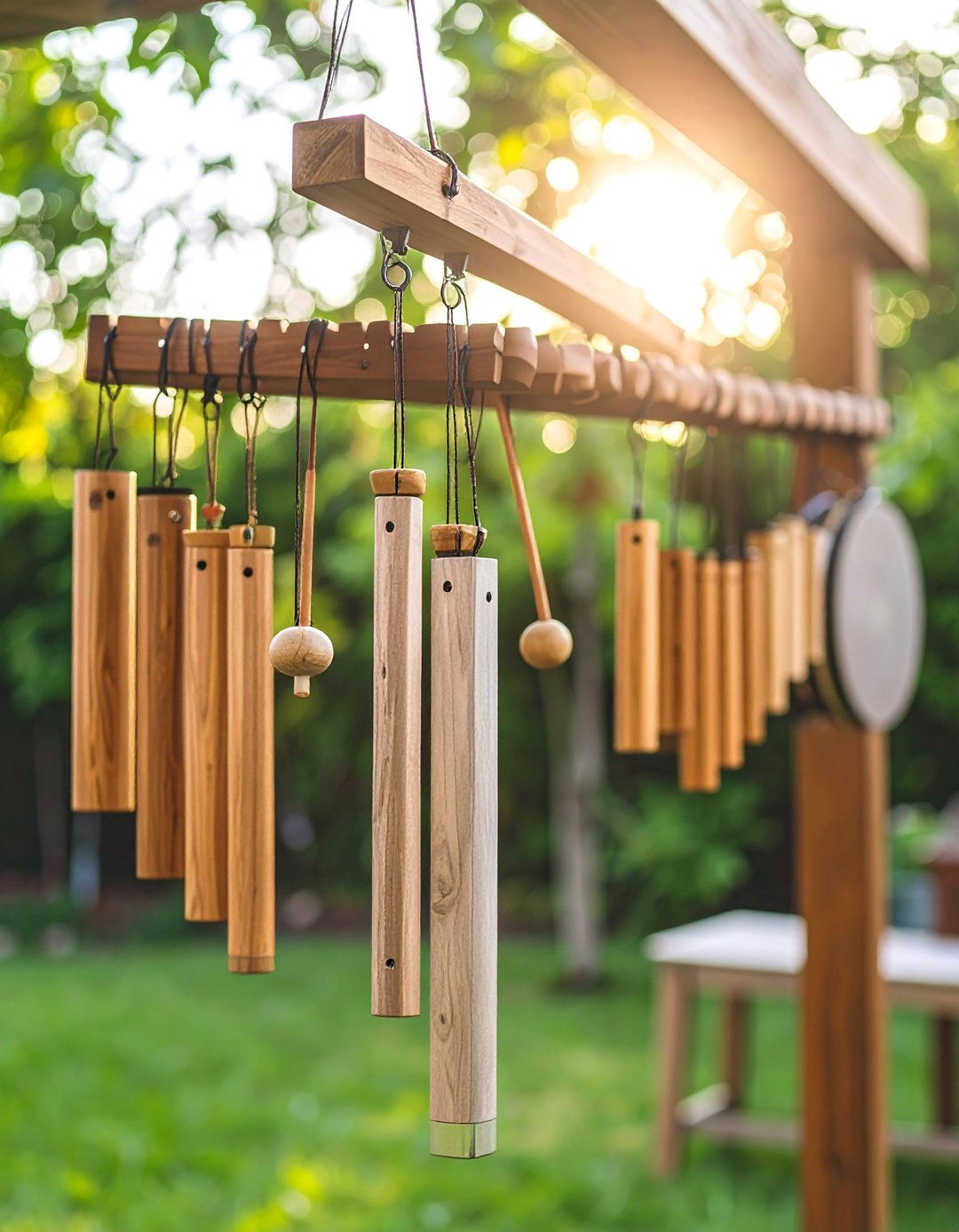
Design an outdoor music area that encourages sound exploration through natural and constructed instruments positioned throughout a dedicated backyard space. This creative zone features hanging instruments like wind chimes in various materials, outdoor xylophones made from natural wood, and drum sets created from different sized containers and natural materials. The area includes performance spaces with natural amphitheater seating arrangements and acoustic considerations that enhance sound quality. Storage solutions protect instruments from weather while keeping them accessible for spontaneous music making. The design incorporates plants that create natural sounds like rustling grasses and leaves, adding to the auditory experience. This musical environment encourages creativity, develops listening skills, and provides opportunities for both solo and group musical exploration while connecting kids to natural sounds and rhythms.
18. Hideaway Fort Building with Multiple Secret Spaces
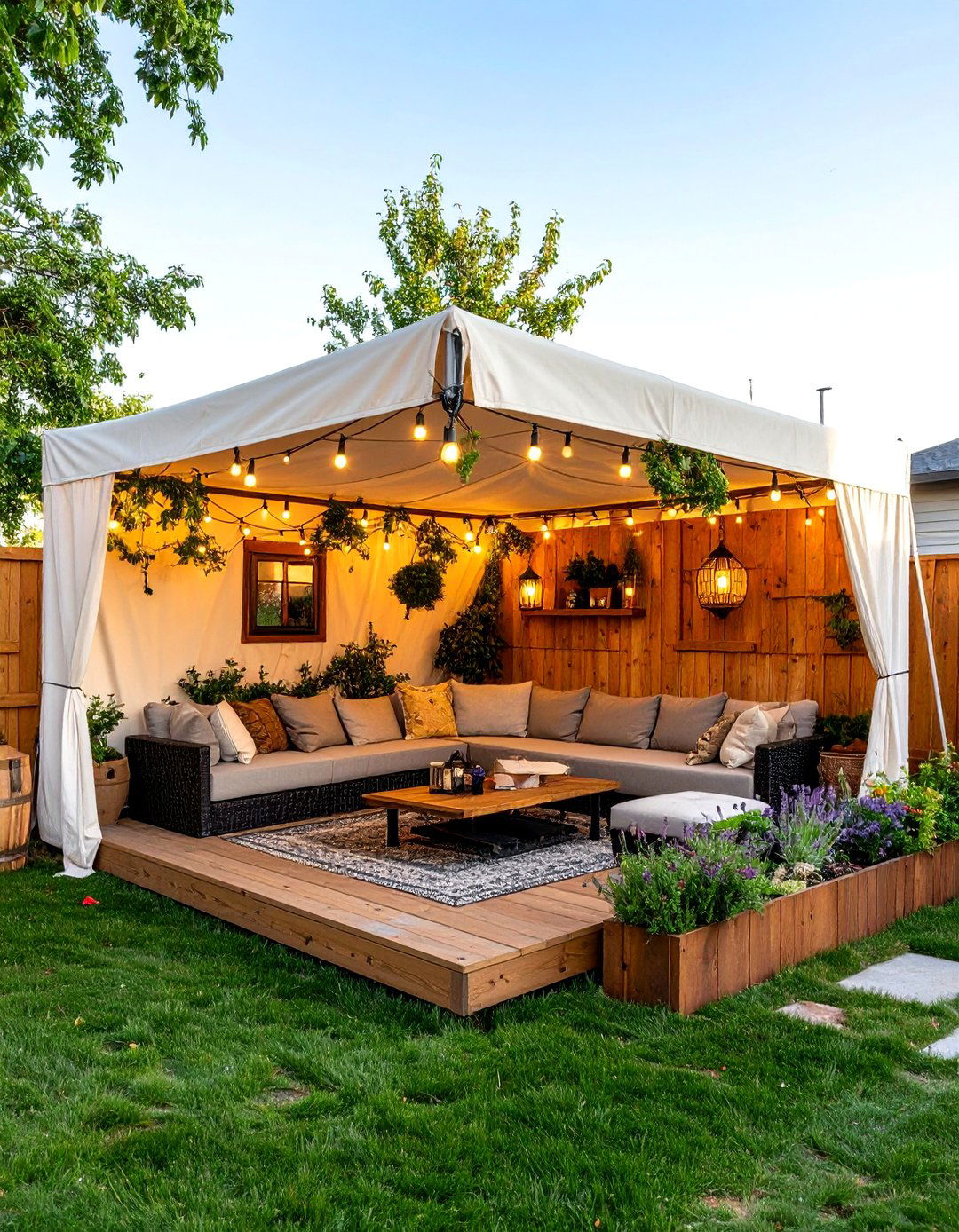
Create a backyard environment that includes multiple hideaway options and fort-building opportunities using both permanent structures and moveable materials. This adventure area features pre-built secret spaces like underground hideouts, tree-based platforms, and camouflaged ground-level forts, plus materials for kids to build their own temporary structures. The design includes supply stations with fort-building materials like lightweight panels, ropes, tarps, and connectors that kids can use independently. Natural elements like dense plantings create additional hiding spots and visual barriers that enhance the sense of adventure. Safety considerations include proper ventilation for enclosed spaces, smooth materials to prevent injury, and sight lines that allow for appropriate supervision. This creative environment encourages independence, problem-solving, and imaginative play while providing spaces for quiet reflection and social bonding.
19. Balance Challenge Course with Progressive Difficulty Levels
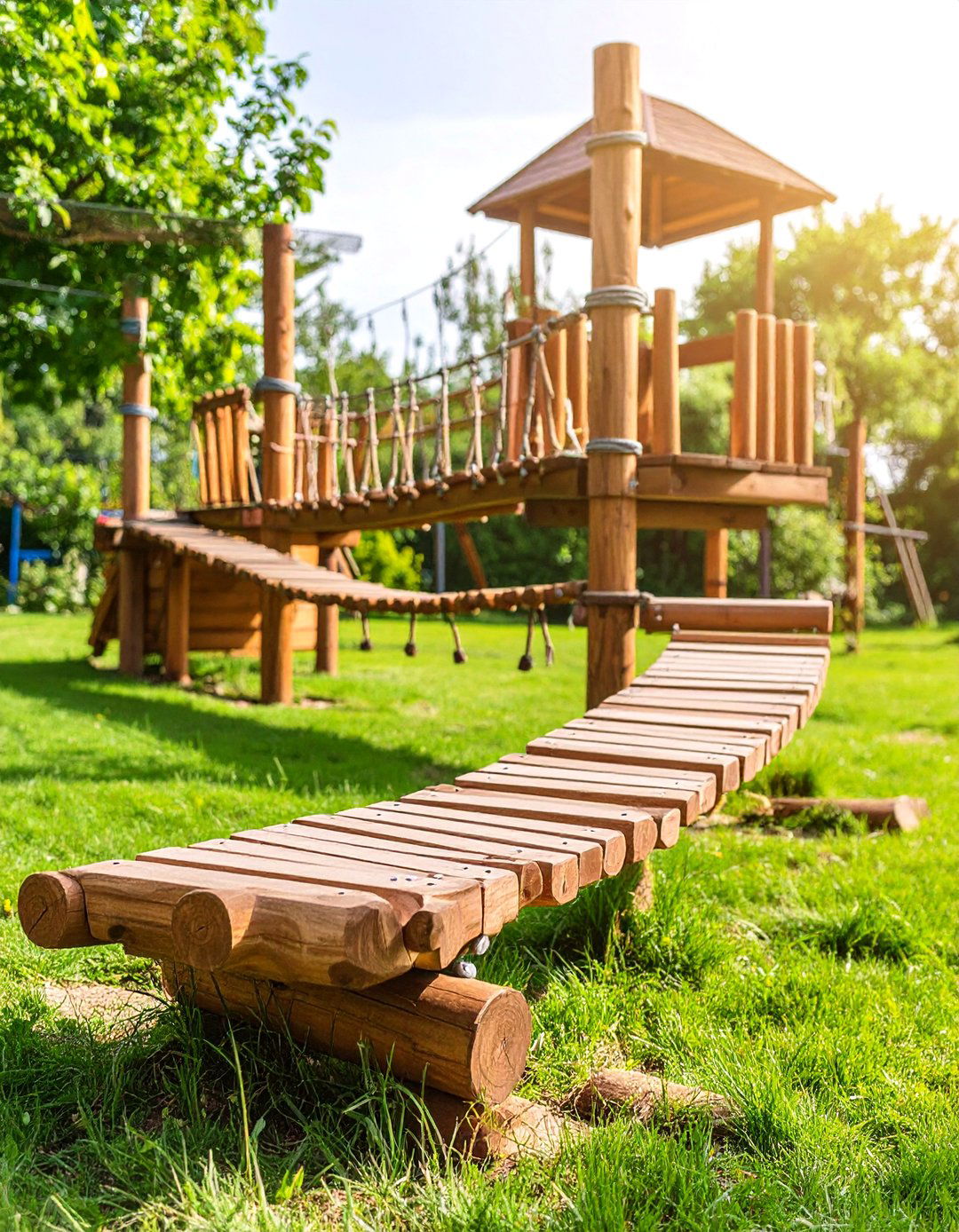
Design a balance-focused course that helps kids develop coordination and confidence through progressively challenging obstacles arranged throughout your backyard space. This area features various balance elements like log beams at different heights, rope bridges, stepping stone paths, and wobble boards, all designed with appropriate safety features. The course layout creates a natural flow from easier to more challenging obstacles, allowing kids to build skills gradually. Safety considerations include proper fall zones with soft ground covering, secure mounting for all elements, and clear spacing between obstacles. The design can incorporate natural materials like tree rounds, logs, and stones, plus manufactured elements that provide specific balance challenges. This developmental environment supports physical growth, builds self-confidence, and provides engaging activities that kids can practice independently or with friends.
20. Picnic Adventure Dining with Outdoor Eating Spaces

Create dedicated outdoor dining areas designed specifically for kids' meals, snacks, and pretend play food activities. This space features child-sized picnic tables, benches, and eating surfaces positioned in shaded areas throughout the backyard. The design includes weather-resistant furniture that can withstand outdoor conditions while remaining comfortable for extended use. Storage solutions keep outdoor dishes, cups, and eating utensils organized and accessible for both real meals and pretend play. The area might include features like built-in coolers, trash and recycling stations, and easy-clean surfaces that simplify maintenance. Surrounding plantings can include edible options that kids can harvest for their outdoor meals. This dining environment encourages outdoor meal enjoyment, teaches independence in food preparation and cleanup, and provides social spaces where kids can host their own outdoor parties and gatherings.
21. Vehicle Race Track with Transportation Theme
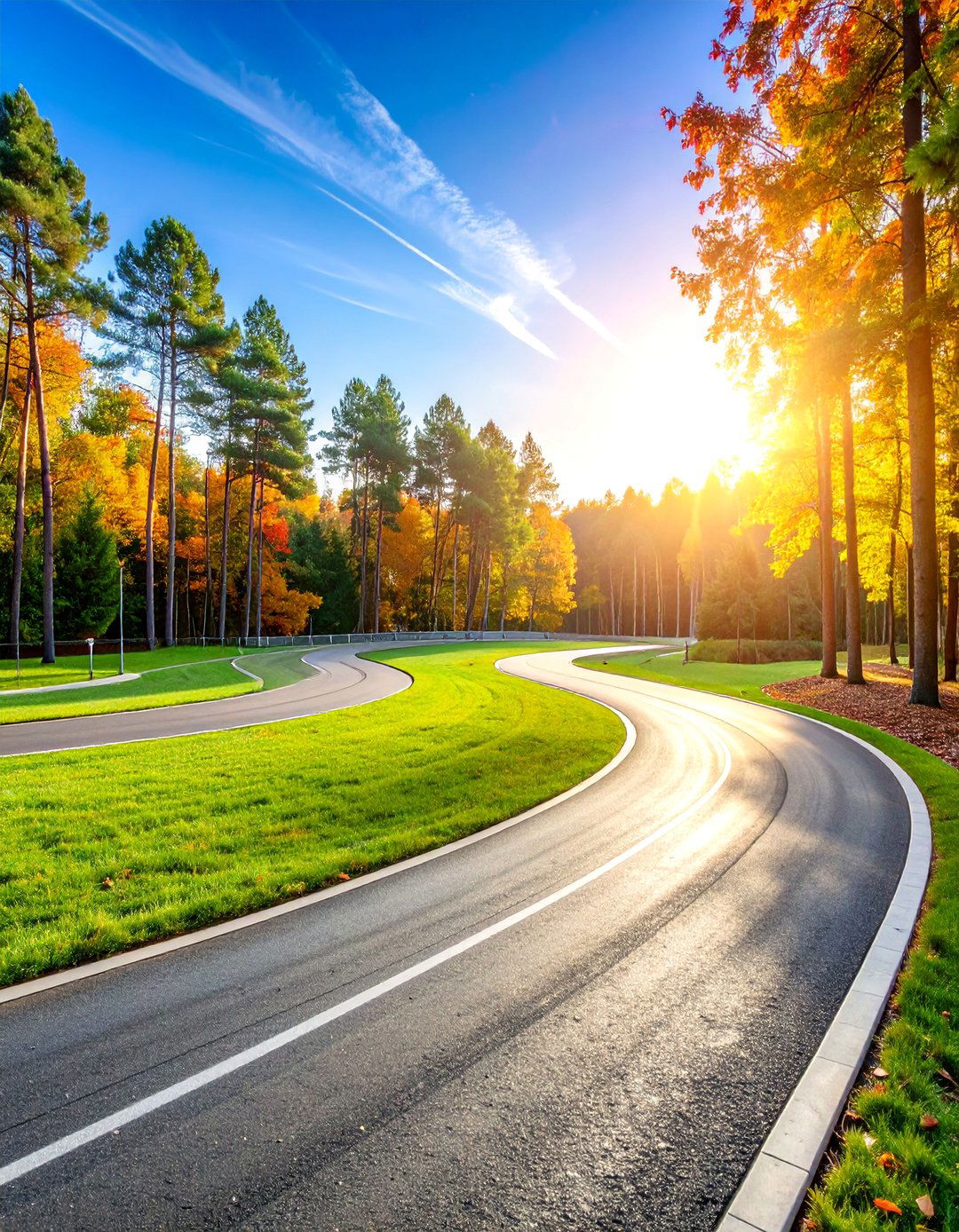
Design an exciting vehicle play area that accommodates bikes, scooters, ride-on toys, and remote-controlled vehicles through dedicated pathways and activity zones. This transportation-themed space features paved or packed-earth pathways that create loops and circuits throughout the available area, with appropriate width for safe passing and turning. The design includes traffic features like stop signs, crosswalks, and directional markings that teach traffic safety while enhancing play value. Storage solutions keep various vehicles organized and protected from weather, while maintenance areas allow for simple repairs and cleaning. The track can incorporate elevation changes, tunnel features, and obstacle elements that add excitement while maintaining safety. This active environment promotes gross motor development, teaches traffic awareness, and provides high-energy play opportunities that can accommodate multiple children simultaneously.
22. Theater Stage Outdoor Performance with Natural Amphitheater
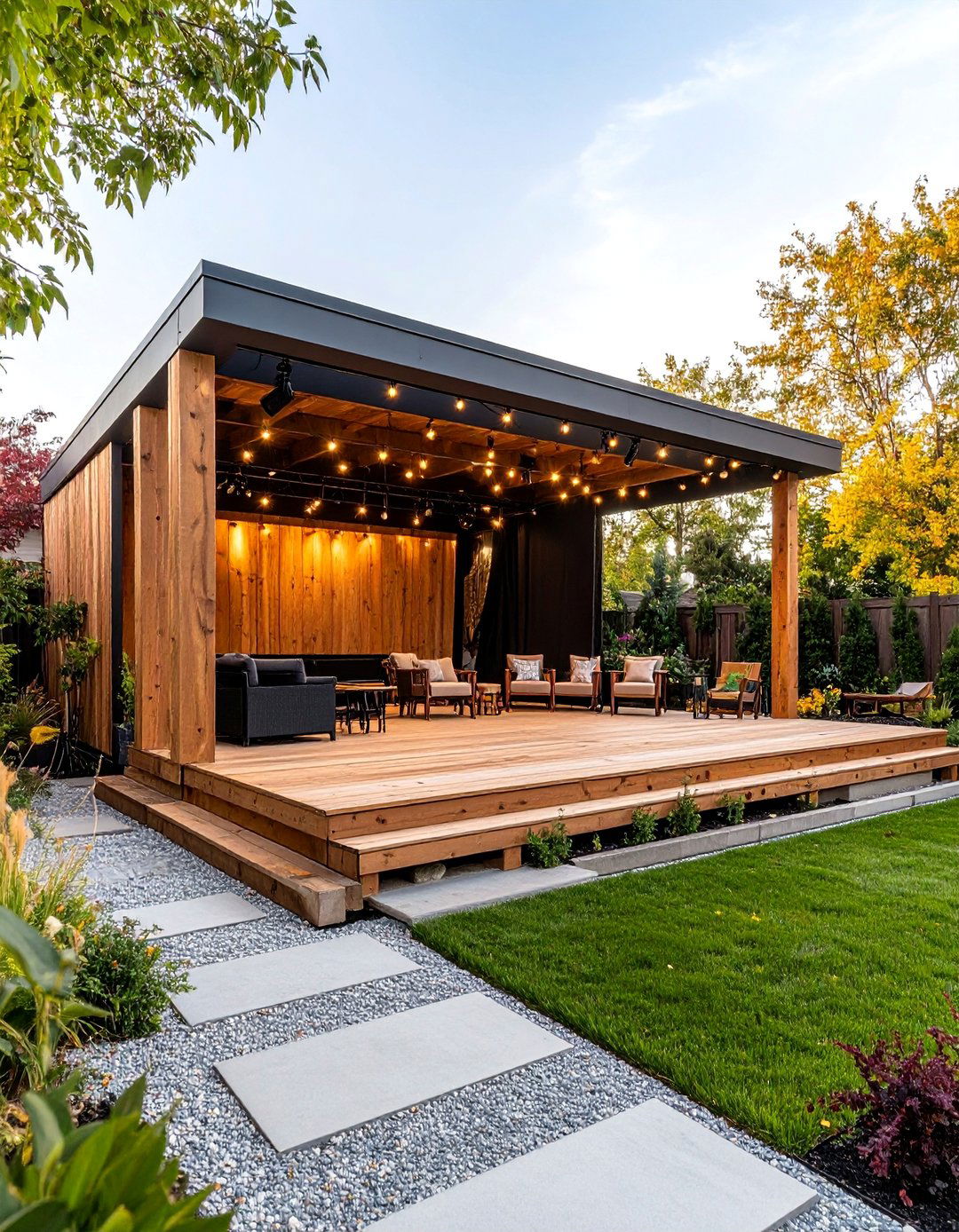
Create an outdoor performance space where kids can engage in dramatic play, puppet shows, and creative performances using natural amphitheater design principles. This entertainment area features a designated stage area with backdrop options, audience seating arranged on natural or constructed terrain, and storage for costumes and props. The design incorporates acoustic considerations that enhance sound projection and audience experience. Natural elements like plantings can serve as stage backdrops and wings, while lighting options allow for evening performances. The performance space can be adaptable for different types of shows, from simple puppet theaters to elaborate musical performances. Storage solutions keep performance materials organized and accessible, while weather protection ensures year-round usability. This creative environment builds confidence, encourages public speaking skills, and provides entertainment for both performers and audience members.
23. Butterfly Garden Habitat with Native Plant Ecosystems
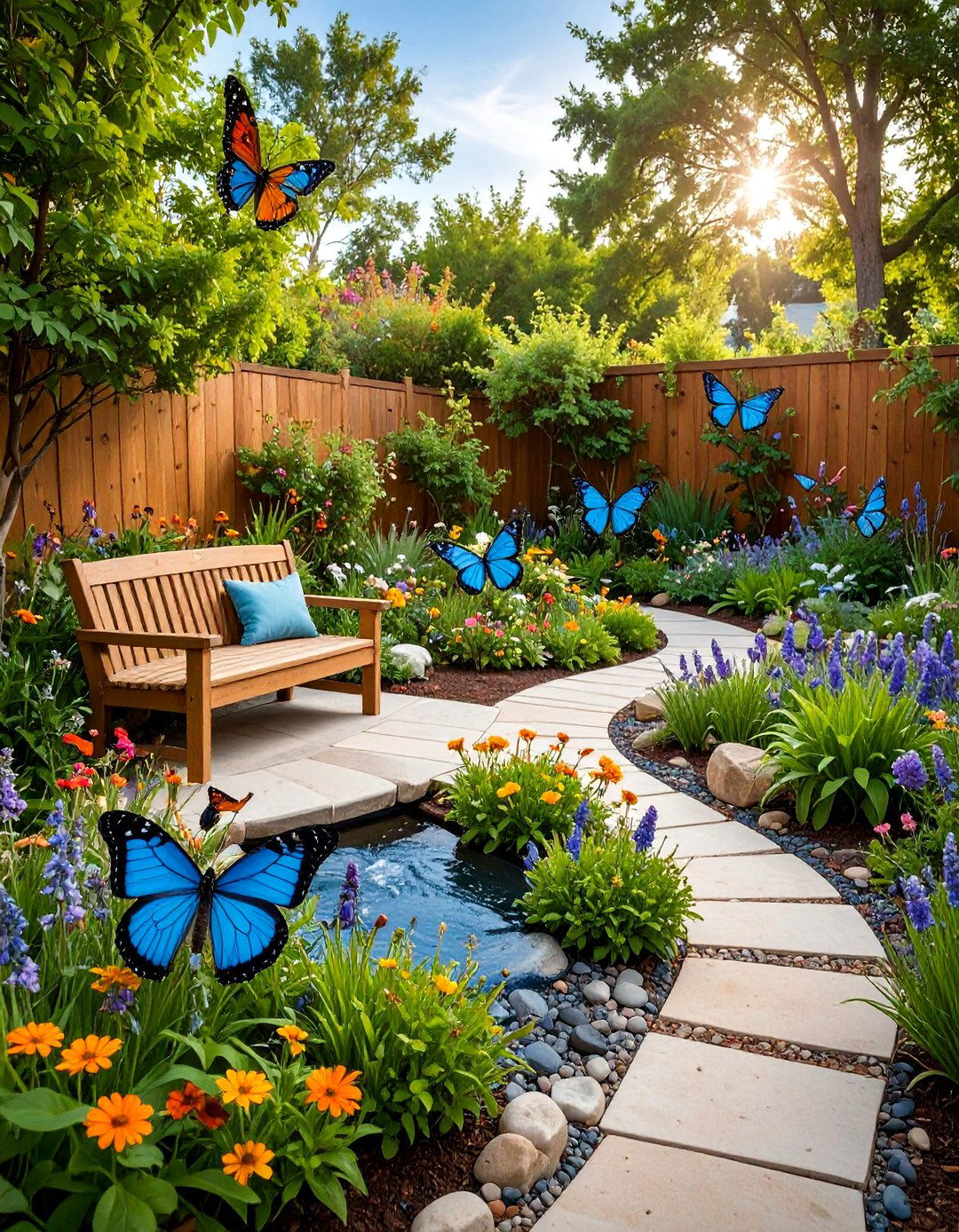
Design a butterfly garden that serves as both a beautiful landscape feature and an educational tool for learning about local ecosystems and wildlife conservation. This specialized area features native plants specifically selected to attract butterflies through all life stages, including host plants for caterpillars and nectar sources for adult butterflies. The design incorporates water features like shallow puddling areas, basking spots with flat stones, and wind protection through strategic plant placement. Educational elements include identification charts, observation areas with seating, and journaling stations where kids can record butterfly sightings. The garden layout creates natural pathways for both human visitors and butterfly movement while maintaining the delicate ecosystem balance. This living classroom teaches environmental responsibility, provides opportunities for scientific observation, and creates a beautiful space that benefits both children and local wildlife populations.
24. Storage Adventure Shed with Organization Systems
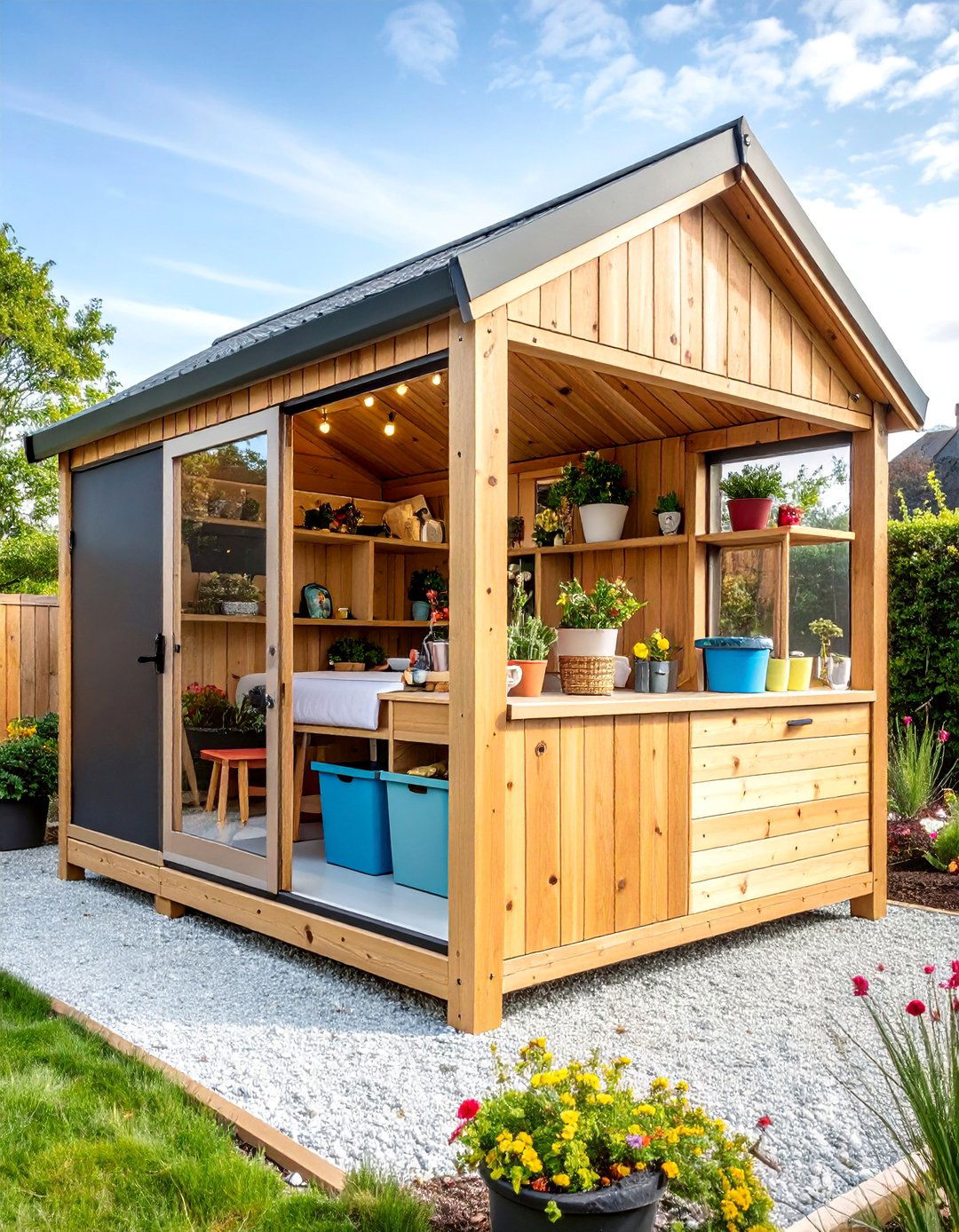
Create a functional storage solution that doubles as an adventure base camp through creative design and organization systems that encourage independent play. This storage structure features designated areas for different types of outdoor equipment, from sports gear to art supplies, with child-accessible organization systems. The design includes external features like climbing elements, chalkboard surfaces, and seating areas that extend the play value beyond simple storage. Interior organization uses clear bins, labeled storage areas, and height-appropriate shelving that allows kids to maintain their own outdoor play spaces. The structure can incorporate windows, decorative elements, and themed features that make storage activities enjoyable rather than chore-like. This practical environment teaches organizational skills, encourages responsibility for personal belongings, and provides a central hub for coordinating various outdoor activities throughout the seasons.
25. Mini Greenhouse Growing Station with Year-Round Gardening
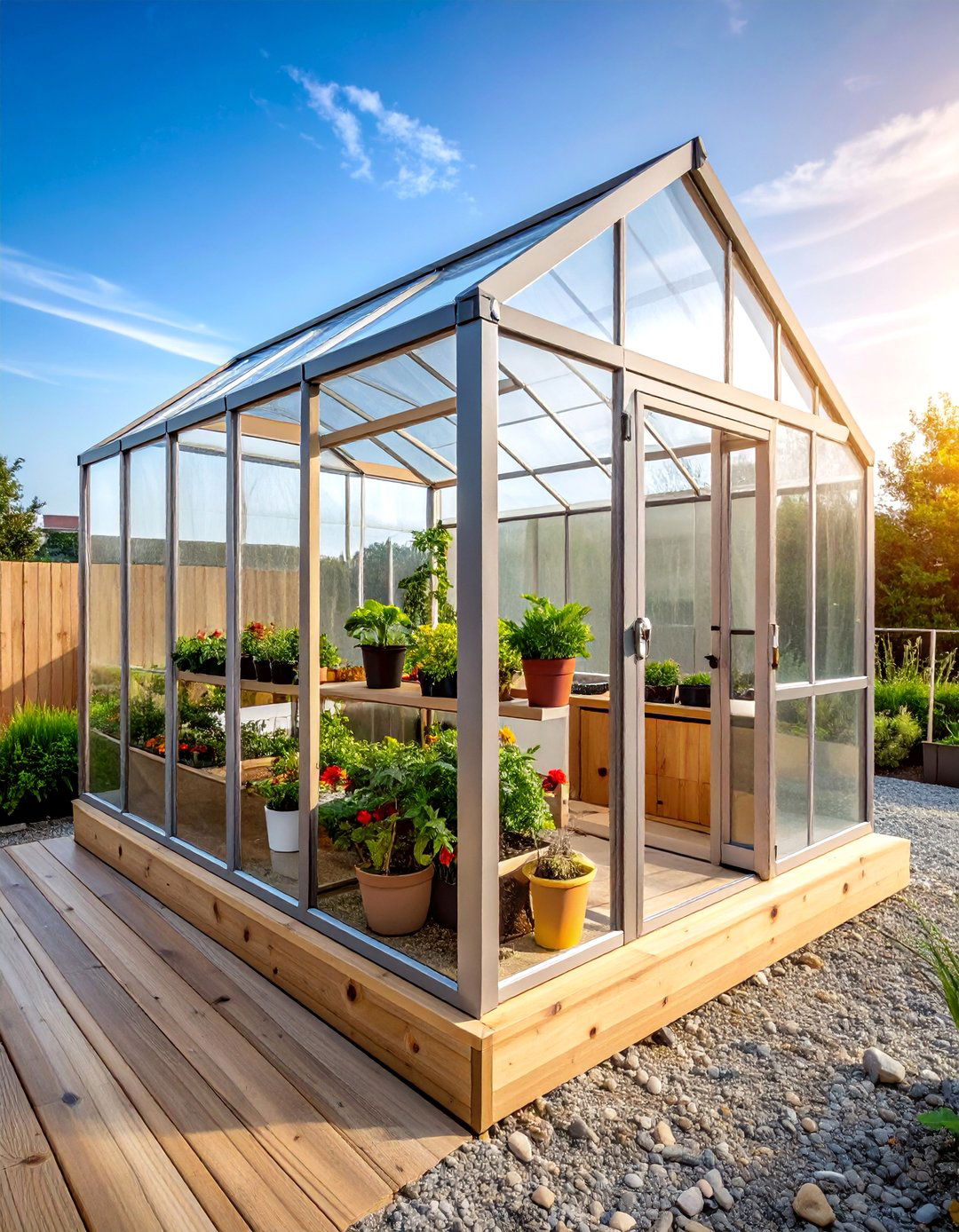
Design a kid-sized greenhouse structure that enables year-round gardening activities and provides educational opportunities about plant growth, weather, and seasonal changes. This growing environment features transparent walls and roof panels, child-height work surfaces, and climate control elements appropriate for your local conditions. The design includes growing areas for various plant types, from seedlings to mature plants, with proper ventilation and temperature regulation. Educational features like thermometers, growing charts, and experiment areas enhance the learning experience. The greenhouse can connect to outdoor garden areas through transitional spaces where kids move plants between indoor and outdoor growing environments. Storage solutions keep gardening supplies organized while remaining accessible to young gardeners. This controlled environment extends the growing season, teaches scientific concepts about plant biology, and provides a protected space for gardening activities during various weather conditions.
Conclusion:
These 25 backyard ideas offer complete design solutions that transform outdoor spaces into engaging environments where kids can explore, learn, and play safely. Each concept balances fun with developmental benefits while considering practical maintenance and safety requirements. The key to successful backyard design lies in creating multiple activity zones that accommodate different interests, energy levels, and age groups. By incorporating natural elements, interactive features, and flexible design principles, these ideas ensure your backyard becomes a destination that grows with your children and provides years of outdoor enjoyment, learning, and memorable family experiences.



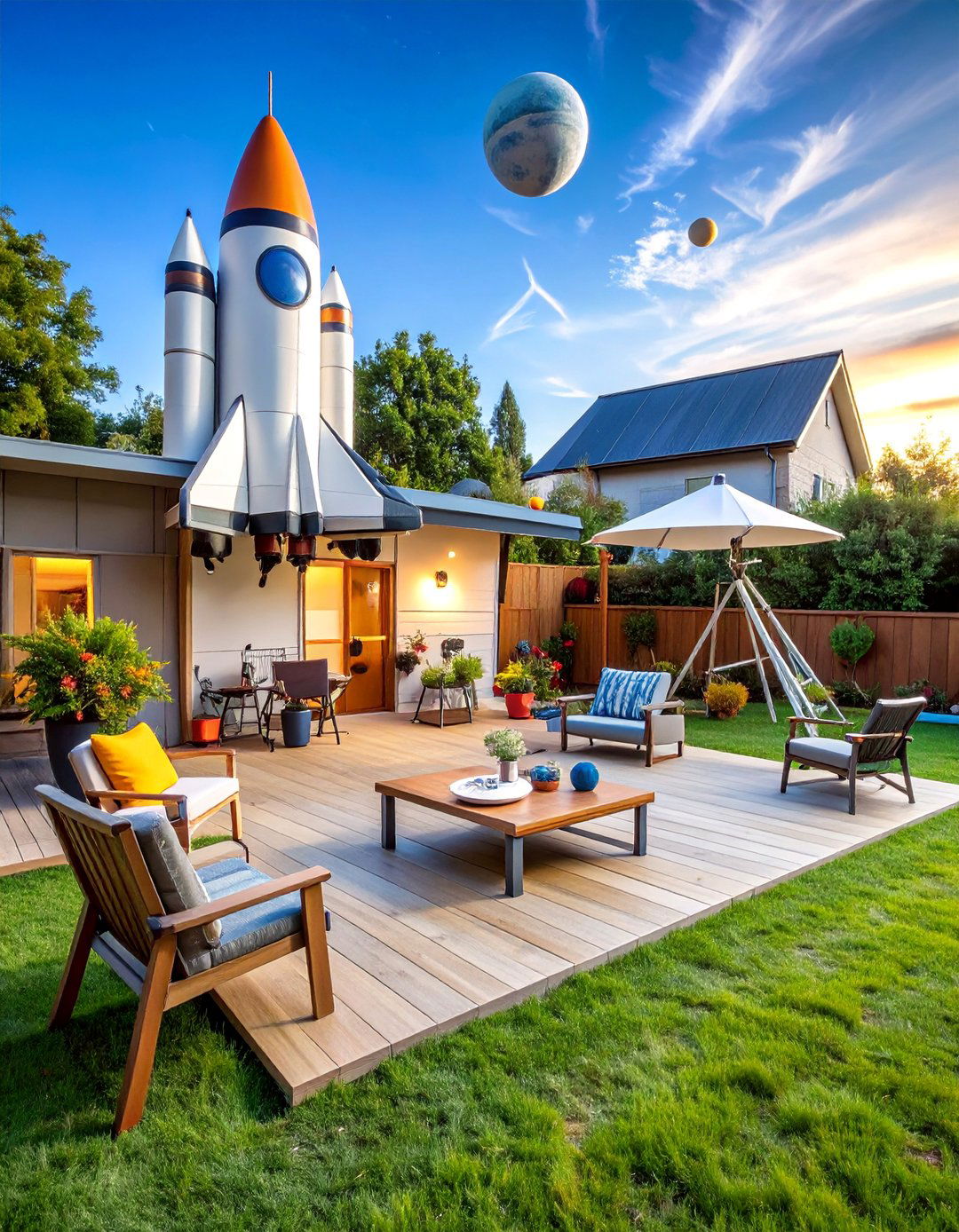
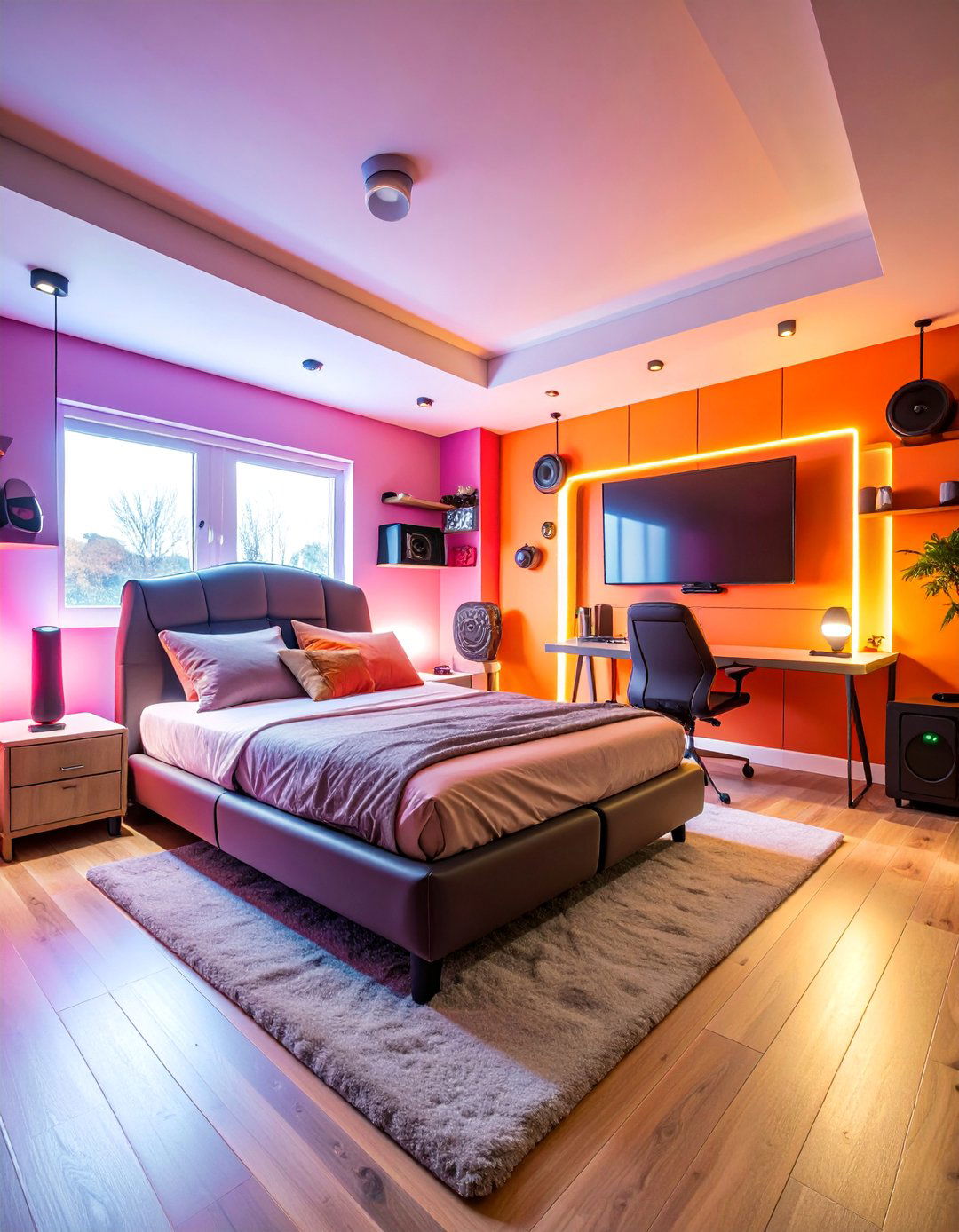
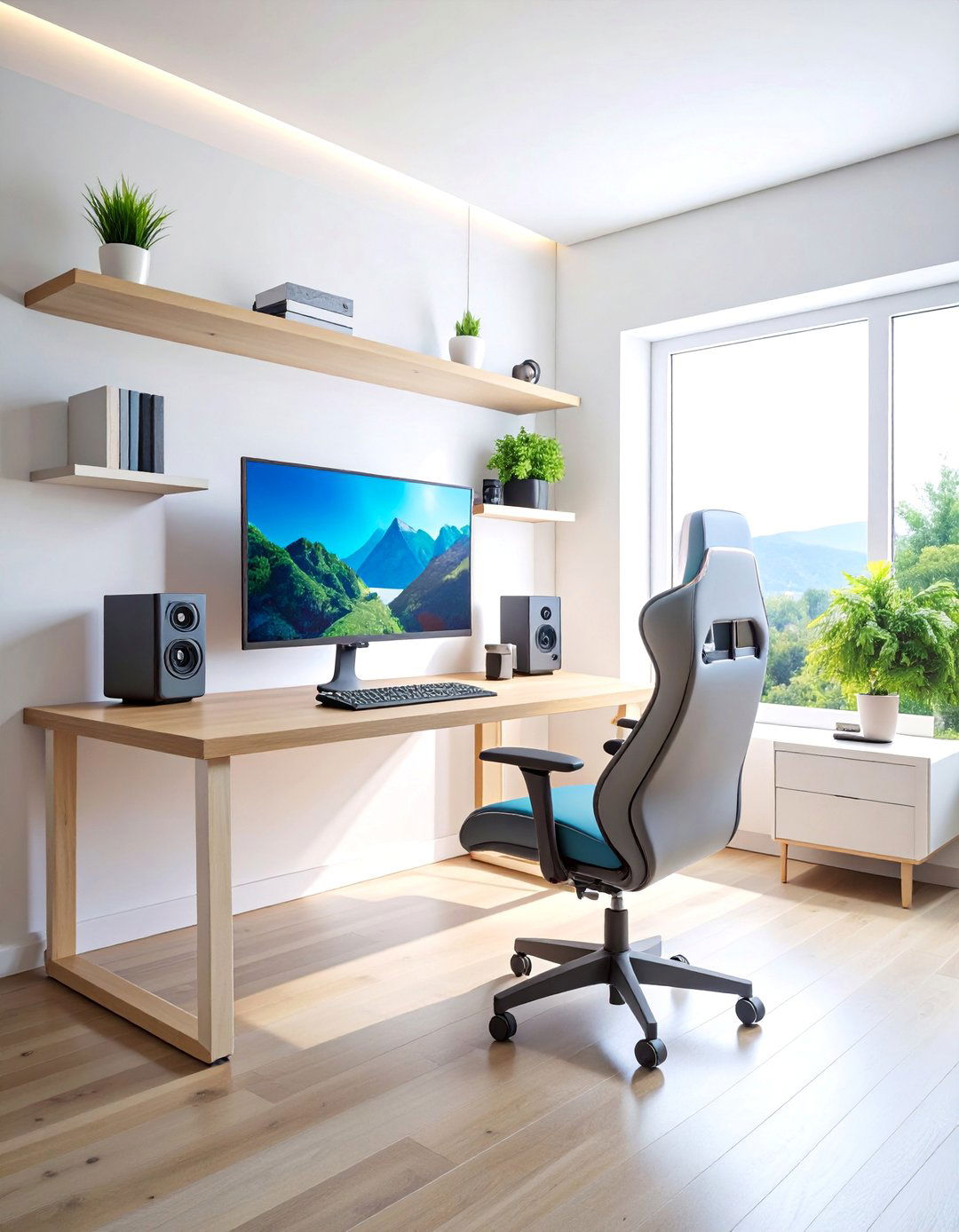
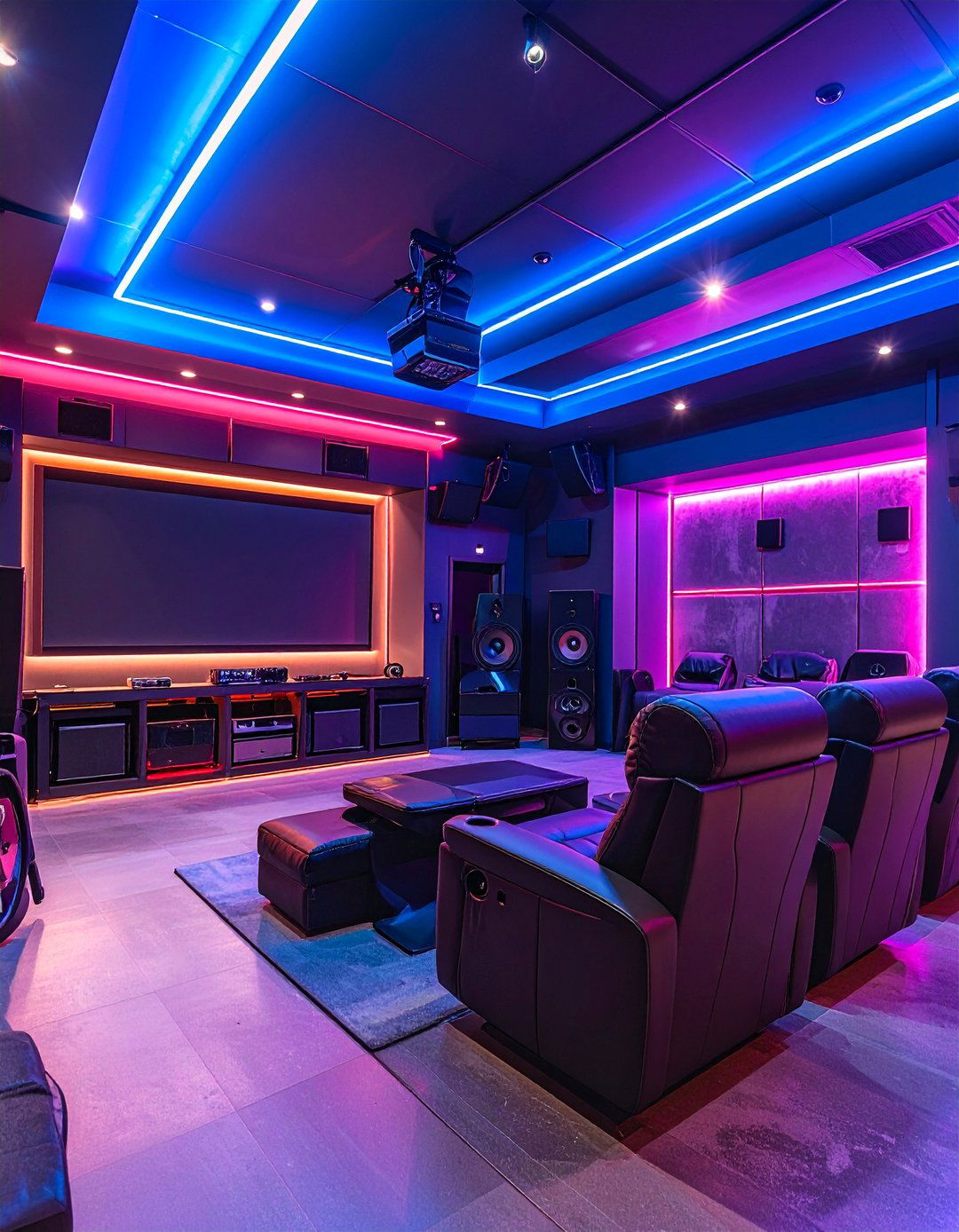
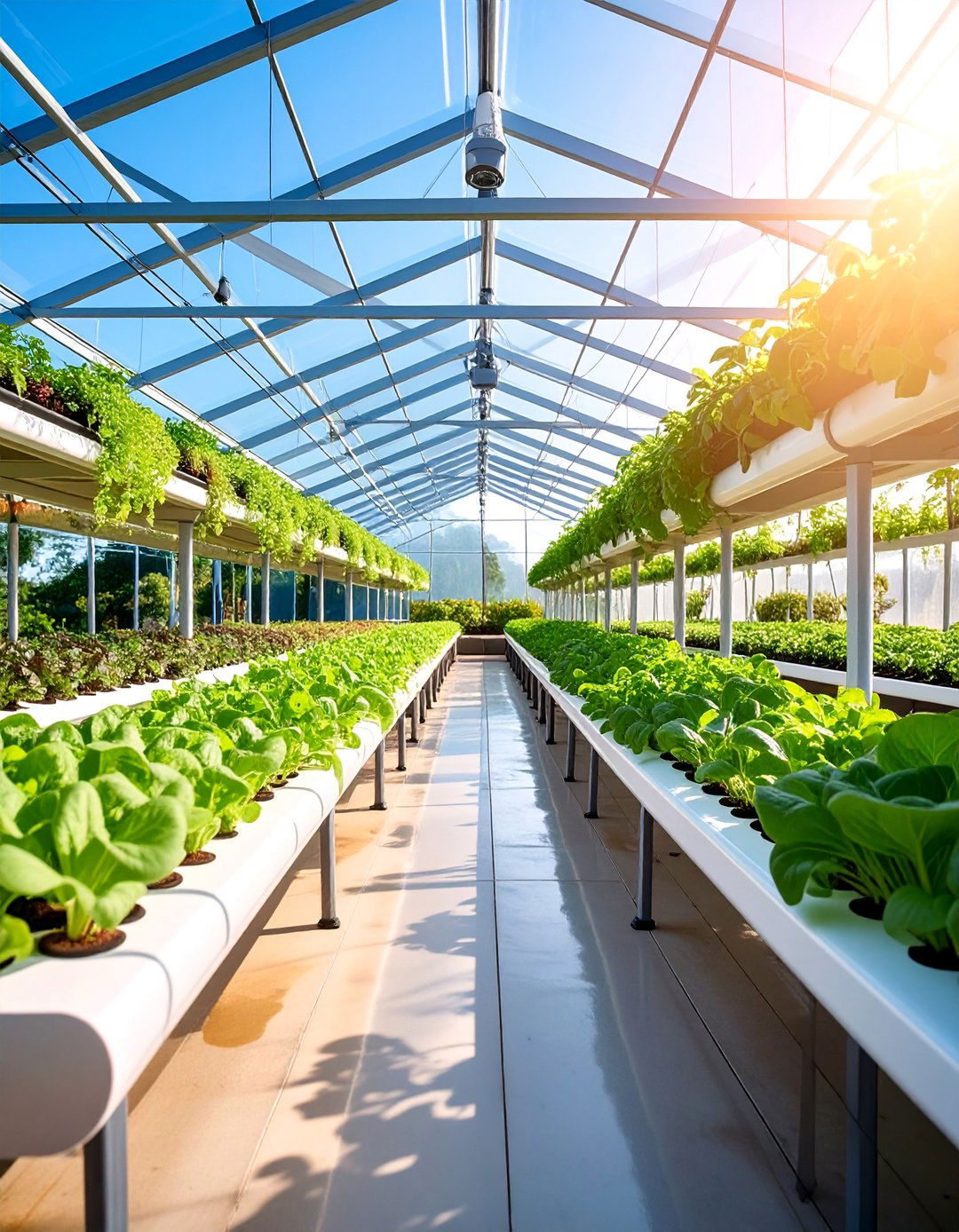




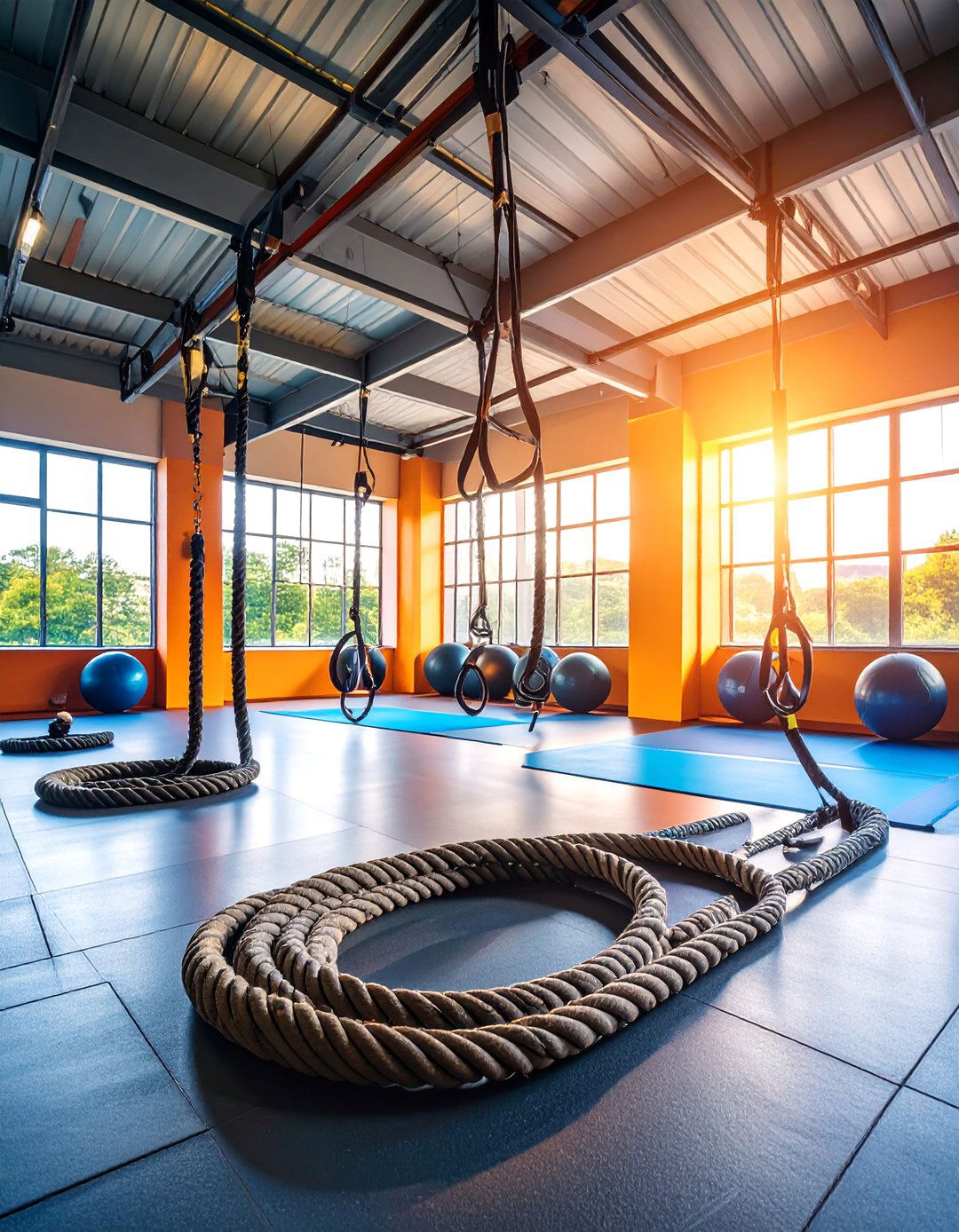

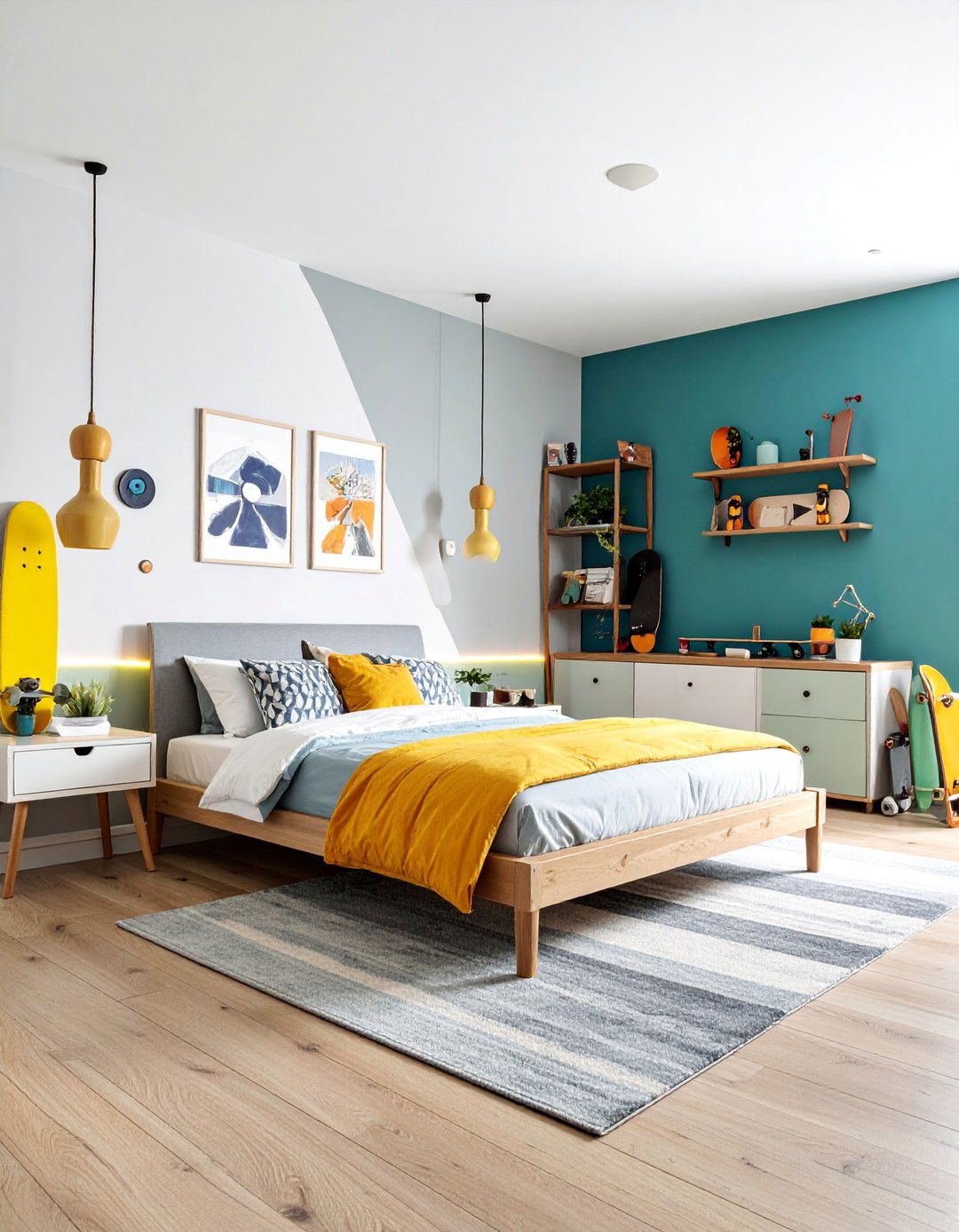
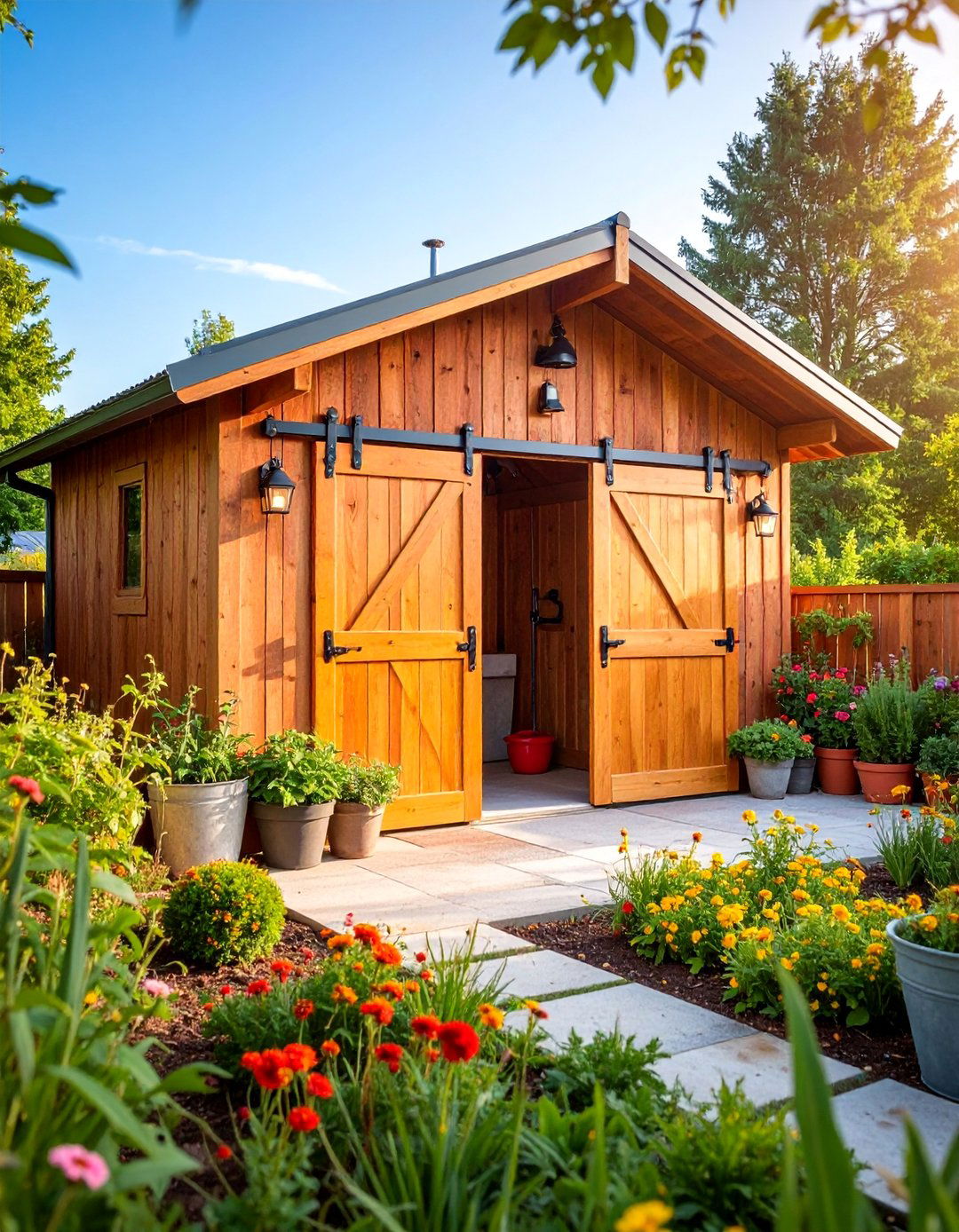
Leave a Reply